【编者按】
一支铅笔,一本素描本,疫情中身处纽约的羅一做的街头画像为何以艺术之名进入著名的白盒子艺术中心做展?又为何会引起纽约研究当代艺术的学者教授们的高度评价?著名评论家安东尼·海登-盖斯特先生这样评说“这是一个后后现代主义的话题……摄影死了……当我看着楼下正展览中的肖像,被它们比大多数照片更重要的意义所震撼。”哥伦比亚大学莱斯教授说“重要的不是做一些看起来像我们在博物馆里看到的东西那样的艺术品,而是艺术家和主题之间的连接,我们可以从羅一作品中的“我”中看到这种联系感。”大卫布鲁贝克教授说:“她的作品成为白盒子在这个大流行时期的一个极好的选择”。中国的中央美院王春辰教授说:这些画像让我们重新思考什么是全球化以及人们如何相互依赖,“国际女性艺术家协会副主席唐梦说,这些面孔让她想起著名的德国摄影师在二战期间为德国民众拍摄的身份档案,起先并没有想会成为那么强有力的艺术。纽约皇后舞蹈学院教授殷梅觉得这些并不愁苦的面容让她忘记了疫情,而见到强大光明之人性。......现在就让我们看看纽约的当代学术圈是如何研讨艺术的。
A pencil’s post-post-Modernist
Only with A pencil and a sketchbook, how did Loy Luo's street portraits in New York during the epidemic were accepted as Big Art by the famous White Box Art Center for an exhibition? Why has it been so highly regarded by scholars and professors of contemporary art in New York? Anthony Hayden-Guest, a noted critic, put it, “I think it's very Post-Post-Modernist to be talking ...... the photography is dead......I’m looking at portraits downstairs, struck, by how much more vital they are than most photographs.”Professor Rice of Columbia University said What's important is not to make art that looks like what we see in museums, but the connection between the artist and the subject, which we can see in the 'I' in Loy Luo's work. Professor David Brubeck said: "Her work has become an excellent choice for White Box during this pandemic." Wang Chunchen,a professor in China's Central Academy of Fine Art said: “The pictures let us rethink what is globalization and how people depend on each other." Tang Meng, The vice chairman of International female artists association, said these faces reminded her of the famous German photographer who shot the identity of the archivesfor the people in Germany during world war II, by which at first he did not want them to become so powerful art. Yin Mei, a professor at The Queen's Dance Academy in New York, felt that these non-sad faces made her forget about the epidemic and see strong and bright humanity. . .Now let's take a look at how the contemporary academic community in New York deals with art.
羅一纽约个展《另一个我》(我在别人中)视频学术研讨会
Loy Luo New York Solo Exhibition "The Other Me" (The Me in Others) Academic Seminar
根据2020年7月31日纽约白盒子艺术中心组织的ZOOM会议实况转录编辑
Edited by ZOOM Conference, organized by WhiteBox Harlem Art Center, New York, on 31 July/2020
主持人:
Host:
莱斯·乔伊纳斯,是哥伦比亚大学当代艺术家和当代视觉文化学者,也是中国人民大学现当代艺术教授。
Les Joynes is a contemporary artist and scholar on contemporary visual cultures at Columbia University and is a professor of Modern and contemporary art at Renmin University, Beijing.
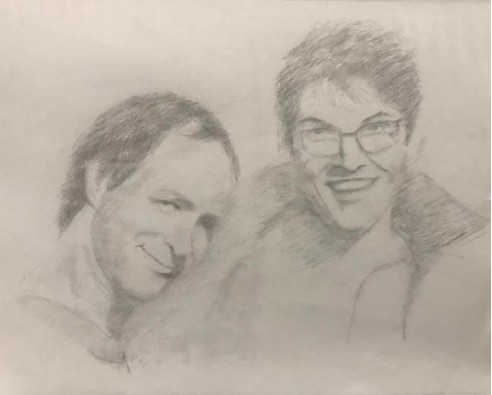
《莱斯和他的朋友》羅一 素描11*14 英寸 2020年8月
Les and his friend Loy Luo Sketch 11”*14”8/2020
演讲者:
Speaker:
羅一,是一位来自北京的中国艺术家。她在纽约的首次个展在哈莱姆区白盒子艺术中心举行。
Loy Luo is a Chinese artist from Beijing. Her first solo show in New York is being held at White Box Harlem.
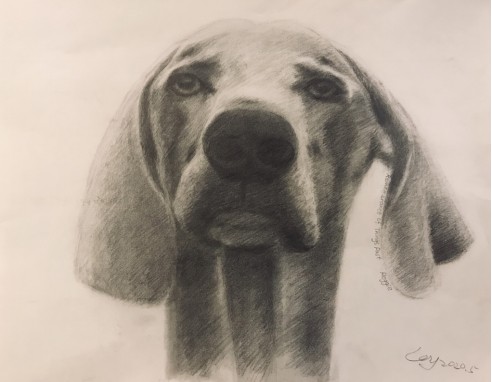
《追忆似水年华》羅一 素描11*14 英寸 2020年5月
Reminiscing about the past Loy Luo Sketch 11”*14”5/2020
王春辰,来自北京,中央美术学院中央美院博物馆首席策展人、副馆长。
Chunchen Wang is Chief Curator and Deputy Director, CAFA Art Museum, Beijing at Central Academy of Fine Arts.
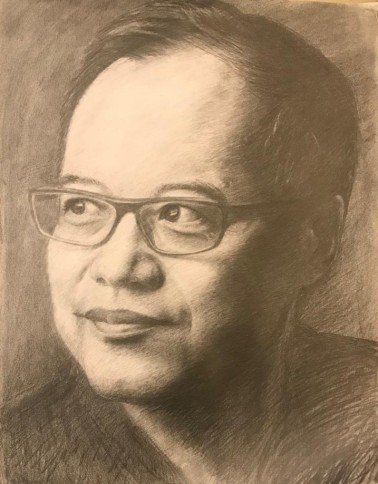
《王春辰》羅一 素描11*14 英寸 2020年3月
Chunchen Wang Loy Luo Sketch 11”*14”3/2020
大卫·布鲁贝克,独立学者,从事美学研究,中国武汉湖北大学艺术与设计学院客座教授。
David Brubaker is an independent scholar with recent research in aesthetics as Visiting Professor at the School of Art and Design, Hubei University, Wuhan, China.
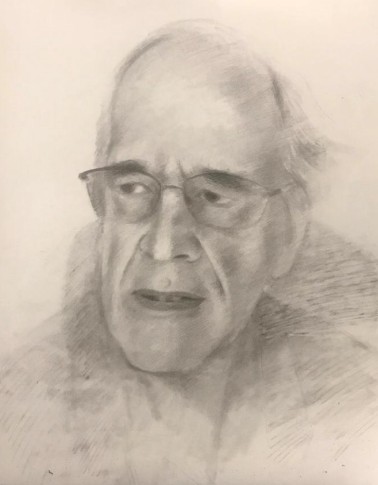
《大卫·布鲁贝克》羅一素描11*14 英寸 2020年8月
David Brubaker Loy Luo Sketch 11”*14”8/2020
殷梅,是一名中国编舞、舞蹈家和导演,现居纽约。她是皇后学院戏剧和舞蹈系的舞蹈教授,也是舞蹈项目的主管。
Yin Mei is a Chinese choreographer, dancer and director based in New York. She is a professor of dance in the Drama, Theatre and Dance Department and director of the dance program, Queens College.
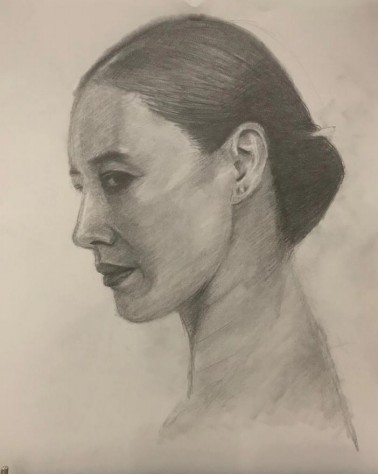
《殷梅》羅一 素描11*14 英寸 2020年8月
Yin Mei LoyLuo Sketch 11”*14”8/2020
安东尼·海登-盖斯特,是一位英裔美国作家、漫画家、艺术评论家和社会名流,住在纽约。
Anthony Haden-Guest is a British-American writer, cartoonist, art critic, and socialite who lives in New York City.
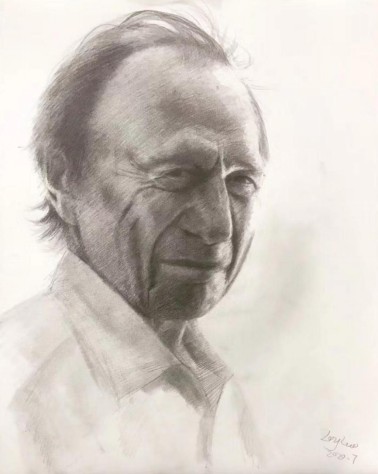
《安东尼·海登-盖斯特》羅一 素描 11*14 英寸 2020年7月
Anthony Haden-Guest Loy Luo Sketch 11”*14”7/2020
唐梦,是国际女艺术家协会副主席,并在明尼苏达大学教授艺术。
Meng Tang is Vice-President of International Association of Female Artist, and teaches Art at the University of Minnesota.
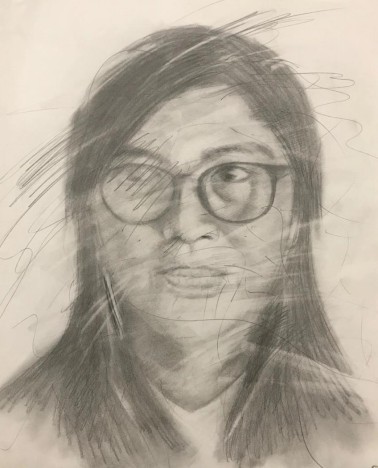
《唐梦》羅一 素描11*14 英寸 2020年8月
Tang Meng Loy Luo Sketch 11”*14”8/2020
佐藤恭子,是哈莱姆区白盒子艺术中心的亚洲项目总监。
Kyoko Sato is Director of Asian Programming, WhiteBox Harlem.
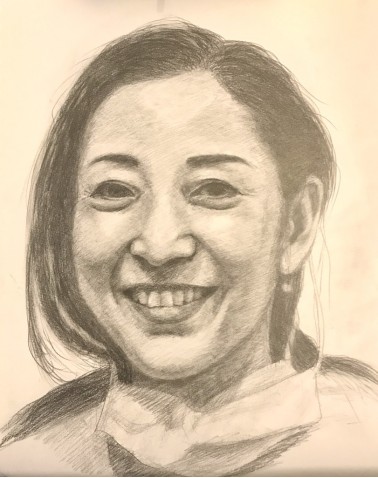
《佐藤恭子》羅一 素描11*14 英寸 2020年4月
Kyoko Sato Loy Luo Sketch 11”*14”4/2020
胡安·庞特斯,是哈莱姆区白盒子艺术中心的创始人和艺术总监。
Juan Puntes is Founder and Artistic Director, WhiteBox Harlem.
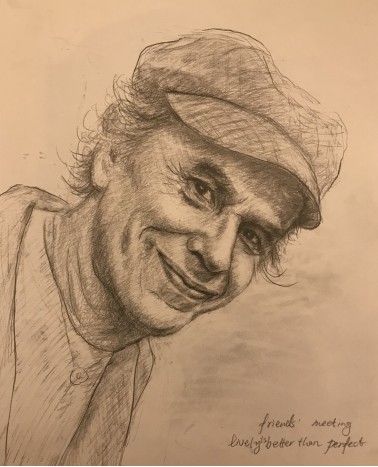
《胡安·庞特斯》 羅一 素描 11*14 英寸 2020年2月
Juan Puntes LoyLuo Sketch 11”*14”2/2020
恭子:
大家早上好,欢迎来到哈莱姆区白盒子艺术中心,我希望你们会喜欢今天的消防队的休息室,一个zoom小组讨论。我是亚洲项目总监佐藤恭子,是中国艺术家羅一当前这个非凡的展览“另一个我(我在别人中)”的策展人。我很自豪地向大家展示这个非常有意义的展览。这个展览展出的是羅一在新冠病毒大流行中的纽约城里正在进行中的肖像绘画行为艺术。羅一今年1月从中国来到纽约,随后遭遇了Covid-19大流行。
罗女士是一位著名的抽象画家和雕塑家,但这一次,在这种不同寻常的情况下,她决定接近街上的陌生人,请求他们允许她为他们画肖像,以赞扬纽约人的坚韧不拔。
现在我将把话筒递给我们的艺术总监,请他来介绍一群优秀的小组成员。
Kyoko: Good morning everyone and welcome to the WhiteBox Harlem, I hope you will enjoy today's Firehouse Lit Lounge, a zoom panel discussion. My name is Kyoko Sato, Director of Asian Programming and curator of Loy Luo's present extraordinary exhibition "The Other I, The Me in Others". I am proud to present this meaningful exhibition of her ongoing portrait drawing performances in New York City under the coronavirus pandemic. Loy Luo arrived in New York in January of this year from China, then encountered the Covid-19 pandemic.
Ms Luo is a known abstract painter and sculptor, but this time around, under this unusual situation, she decided to approach people, strangers in the streets, and requested that they allow her to draw their portraits in order to celebrate New Yorkers’ resilience.
Now I will pass the mike to our artistic director to introduce a gorgeous group of panelists.
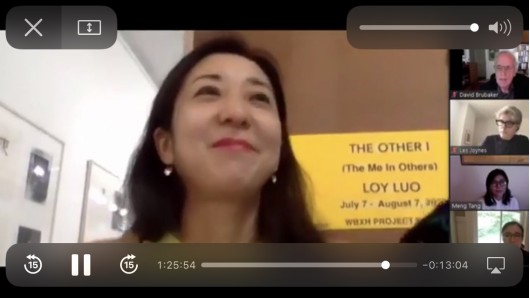
胡安:
早上好。欢迎回到哈莱姆区白盒子艺术中心。今天我只想介绍我们的主持人,莱斯·乔伊纳斯Les Joynes。莱斯是一位伟大的当代艺术家。他曾在哥伦比亚大学教授当代艺术史,也曾在中国人民大学教授当代艺术。稍后他会给大家介绍羅一在疫情期间的工作。羅一所做的,本质上就是在街上游荡,找到人们,让他们摘掉面具,这在今天是不容易做到的。羅一给他们的脸拍照,然后在她的工作室里安静地画上一、两天或三天。不要低估这些日子,这只是让他们的形象在画像中鲜活起来。这个展览是为了庆祝纽约人在流行病过程的恢复能力。
好吧,我们有过911的经历,所以现在我们有了另一段经历。我刚从王春辰那里听说北京一切都很好,所有的餐馆和酒吧都在营业,而我们这里还在关闭。
Juan: Good morning everyone and welcome to WhiteBox Harlem. Today, I will simply limit myself to introduce Les Joynes who will be our moderator. And Les, let me tell you, is a great contemporary artist. He’s taught contemporary art history at Columbia University and treaches contemporary art at RenMin University, Beijing. He will moderate and bring you to, in a moment, to talk about the work of Loy Luo during the Pandemic. What she is doing really, in essence,is to roam the streets, find people, ask them to take their masks off—which is not easily done today—take photos of their faces and then draw them quietly in her studio for one,two,or three days at a time. Don’t underestimate the lasting time, full days as this is to just showcase the ‘attitude’ or live gaze in those portraits. This exhibition celebrates the resilience of New Yorkers under the Pandemic. All right, we had had the experience of 9/11 so now we have this other one. I just heard from Chunchen Wang that Beijing is doing just fine, all the restaurants are open, all the bars are open, and here in New York we are still shut down.
莱斯:
非常感谢,我很荣幸来到这里,感谢白盒子艺术中心的创始人和艺术总监胡安·庞特斯,以及本次展览的策展人佐藤恭子。谢谢你们两位的邀请。
今天很荣幸来到这里和大家一起参加我们的中美跨文化对话,并见到羅一。她是一位来自北京的中国艺术家,这是她在纽约的第一次个展,现在正在哈莱姆的白盒子艺术中心举行。我们有机会和羅一交谈,并对她的艺术有了更多的了解。能够看到她应对疫情的艺术创作是一种荣誉。
我来介绍一下今天的主讲人:王春辰是北京中央美术学院美术馆的首席策展人兼副馆长。他现在正在中国深圳连线我们;大卫·布鲁贝克,他是独立学者,来自康涅狄格州,是在中国武汉湖北大学艺术与设计学院教学;还有殷梅,常驻纽约的中国编舞、舞蹈家和导演。她是皇后学院戏剧、戏剧和舞蹈系的舞蹈教授。今天和我们在一起的还有安东尼·海登-盖斯特,他是一位住在纽约的英美作家、漫画家和艺术评论家。最后,我们请来了唐梦,她是国际女性艺术家协会的副主席,在明尼苏达大学教授艺术。
欢迎大家。感谢大家今天来参加这个重要的、跨越我们两种文化的对话,并向大家介绍艺术家羅一。我想先说一下,我事先有机会和羅一交谈并有机会看了她的艺术作品。了解一个人的异国身份本来就是非常有趣的,而当一个人来自一个正在经历流行病的国家,不能回去,却又看到流行病在她所访问的国家蔓延,这时候对身份的确认更是一件非常特殊的事情。
所以,她的艺术完全是有先见之明的。对于今天的艺术家如何应对Covid-19,如何应对已经产生的人与人之间的距离,她提供了一个更好的理解方式,她用自己的作品来启动对话以获得纽约人的心并同时获得了对他们的印象。所以,再次感谢你们今天来到这里。羅一,你能跟大家打个招呼吗?
Les: Thank you very much, I’m honored to be here, and thank you Juan Puntes, the founder and artistic director of White Box, and Kyoko Sato, the curator of this exhibition. Thank you both for your invitation.
It is an honor to be here with all of you today with our US-China cross-cultural dialogue, and meet Loy Luo, who is a Chinese artist from Beijing, and this is her first solo show in New York now being held at WhiteBox, Harlem. We had the opportunity to talk to Loy and learn more about her art, and it is an honor to be able to look at art created and responding to the Pandemic.
I will introduce our speakers today: Chunchen is Chief Curator and Deputy Director of the Central Academy of Fine Art’s Art Museum in Beijing. We also have David Brubaker, an independent scholar most recently at the School of Arts and Design, Hubei University, Wuhan, China, who joins us today from Connecticut.
Chunchen Wang is joining us today from Shenzhen in China. We also have Yin Mei, Chinese choreographer, dancer and director based in New York. She is a professor of dance in the Drama, Theatre and Dance Department and Program at Queens College. Also with us today is Anthony Haden-Guest, a British-American writer, cartoonist, and art critic based in New York City. And finally, we have Meng Tang, Vice President of the International Association of Female Artists who teaches art at University of Minnesota.
To all of you, welcome. Thank you for joining us today for this important presentation, across both of our cultures and to introduce Loy, the artist. I'll start out by just mentioning that we have had a chance to talk to Loy and I had the opportunity to look at her artwork. It's a very interesting approach to understand one's identity coming to a foreign country, but it's a very special thing indeed to discover one's identity, coming from a country that's experiencing a pandemic, when one cannot go back, and also watching a pandemic unfold in the country one is visiting.
So, her art is entirely prescient and presents a better understanding of how artists today are responding to Covid-19, and responding to the distance that it has created between individuals, where she has used her own artwork to initiate a dialogue to get to the heart of New Yorkers and create an impression about them. So, thank you again for being here today. Loy, could you say hello to everybody?
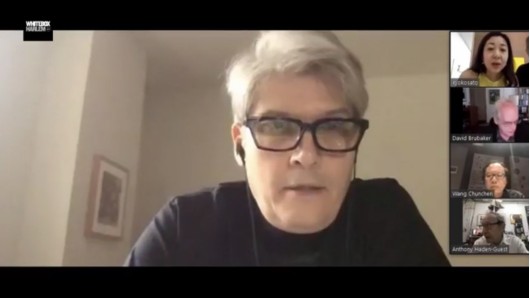
羅一:
你们好!抱歉,我很紧张。这么多杰出的人出席这次对话使我感到非常荣幸,非常感谢!
Loy: Hi! I’m nervous, because there are so many excellent people. I feel very honored, I am full of gratitude. Thank you very much!
莱斯:
你能来这里是我们的荣幸。所以,我想说的是我们看了一些记录她的经历的绘画。对于我们,与一位正在经历疫情的来自中国的艺术家见面是一次难得的机会。
我们谈到的其中一件事就是“面具”。我们都很清楚戴面具的意义,但羅一,你也看到了解蔽或揭蔽面具——或者说是物理面具和物理面具之后的面具之间的谈判。你能谈谈面具的概念以及你如何定义别人里的“我”吗?
Les: It’s our honor to have you here. So, I would like to mention that we looking at some of her drawings that document her experience. This is a unique opportunity to meet an artist from China who is experiencing the Pandemic.
One of the things that we talked about was the “mask”. We're all very much aware of wearing a mask, what that means, but also, Loy, you were looking at the discovery and removal - or the negotiation between the physical mask and the mask behind that. Could you talk a little bit about the idea of the mask and how you identify the ‘I” in others?
羅一:
如果我不那么紧张的话,我想我可以表达得更好。我尽力吧。您问了我两个问题,第一个是关于面具的。当然,面具有不同的含义。一个是物理面具,在中文里是口罩;但我更关注人们的精神面具。因为,在纽约人还没有开始使用物理面具时我已经开始为人们画肖像。我发现一个很有趣的事情,即伴随不同的情绪,人们有很多不同的面孔。
如果人们使用的是物理面具,我可以说“请放下你的面具”,但当我面对的是精神面具,我就不能很容易地说“请放下你的面具”。于是我找到了一种方法,即为他们拍摄很多很多照片,捕捉真实瞬间并在其中选择在我看来最真实的一个,用以表达一些东西。当人们看着自己在画中的脸时,大部分人会非常惊讶:哦耶!这是“我”。
正是当纽约城的人们都戴上了自己的有形面具时,才刺激我重新思考有形面具与精神面具的关系。
Loy: If I wasn’t so nervous, I think I could have put it better. I'll do my best. You asked me two questions. The first is about the mask. Of course, mask has different meanings. One is a physical mask, which in Chinese is a Kouzhao. But I'm more concerned with people's psychological masks. Because I started painting people's portraits before New Yorkers started using physical masks, and what I found really interesting was that people have a lot of different faces, with different emotions.
If people are using a physical mask, I can say "please put down your mask," but when I'm facing a spiritual mask, it is not easy to say "please put down your mask." So I found a way to solve the problem. That is to take many pictures for them, and then capture the real moment and choose the one that seemed most real to me to express something. When people look at their face in the painting, most of them are surprised: Oh yeah! This is me.
It is when people in New York City put on their physical masks that I am stimulated to rethink the relationship between physical and spiritual masks.
莱斯:
谢谢。现在我想让我们的小组讨论。有谁从中获得了东西吗?
Les: Thanks. I’d like to open this now up to our panel today. Will anybody like to pick up from that?
安东尼:
嗯,我认为这是有关后后现代主义的谈话。谈到我们自己的照片,观看我们自己的照片,而且是非常好的照片,我说的是艺术肖像。当19世纪早期到中期的法国历史画家保罗·多洛拉夫斯基看到早期的照片时,他说过一句名言:从今天起,摄影已经死亡。我认为iPhone基本上扼杀了摄影的形式。当我看着楼下正展览中的肖像,被它们比大多数照片更重要的意义所震撼。大卫曾说过,艺术可以达到摄影所不能达到的境界,我认为这是非常真实的,非常能代表我们的生活。好的,就是这样。
Anthony: Well, I think it's very Post-Post-Modernist to be talking, looking at photographic images of ourselves, and pretty good ones too. I’m talking about art portraits. When Paul Doloravsky, French history painter in the early to mid nineteen century, saw early photographs, he famously said from today the photography is dead. Well, the iPhone has basically kind of killed photography’s form, I think. I’m looking at portraits downstairs, struck, by how much more vital they are than most photographs. And David’s talking said the other day that art can go what photography cannot, and I think that is deeply true, very representational of our lives. Okay, that's it.
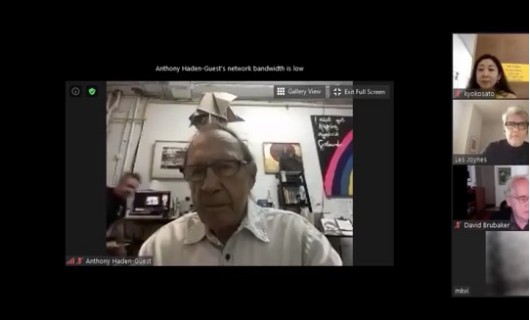
莱斯:
大卫,从康涅狄格州来参加我们的节目,你能加入我们的谈话并分享一些想法吗?
Les: David, who is joining us from Connecticut, could you join our conversation and share some reflections?
大卫:
当然。我很高兴与大家分享我对这个优秀的创新作品的想法。而且,我同意“后后现代主义”这个说法。当你阅读羅一在网上发表的文章时,很明显,她对个人如何进入和摆脱连续的身份的方式感兴趣。但与此同时,它还不止于此,因此还处于实验阶段。正如她所说,她的作品也是关于一个人作为一个独特的或“卑微的”人类个体的存在:这种独特性不是通过对社会中行为、习惯或身份的事实陈述来表达的。它在两个方面是后后现代的。首先,羅一正在探索这样一种想法,即徒手绘画的媒介毕竟可能与视频或实物一样有价值,能够真正直接地表达对生活的认识和人与人之间的接触。其次,她的艺术作品正在检验这样一种观点,即当现实生活仅被定义为用以区分群体所实际理解的表演和行动时,人类存在的某一方面就被忽视或遗忘了。于是她的作品成为白盒子在这个大流行时期的一个极好的选择,当此时,网上和街头的声音暗示着人类文化的基本价值正被重新审视和刷新。现在有一个不能否认的说法:不适当的结构正导致一些人群比其他人经历更多的风险、伤害和危险。这些群体是可以确定的,伤害是真实的,支持也需要真实的。与此同时,他们还谈到了“人性”、“在一起”以及对每个独特的人类个体的同理心。很明显,街头的声音是受到一种通过经济、社会和国家差异传播和渗透的人性理念的启发。这就是我从这件作品中得到的:探索客观身份与人类存在的隐私之间的关系。还有一件事。羅一的肖像画制作方法很有趣。她遇到一个特定的人,收集一组不同的肖像图像,选择其中一个打破了先入为主观念的图像,然后开始通过绘画来诠释和传达它。她认为最终的结果传达了关于人类个体存在的一些重要而新鲜的东西。她说狗的肖像帮助她发展这种方法!我希望我们能谈谈这个。
David : Sure. I’m very glad to share thoughts about this excellent innovative work. I agree with the term “post post-modernist.” When you read Loy Luo’s writings posted online, it is clear that she is interested in the ways that individual human beings move into and out of successive identities. But at the same time, it is more than that and therefore experimental. As she puts it, her work is also about one’s own existence as a unique or “humble” human individual: a uniqueness that is not expressed in factual statements about the actions, habits, or identities performed in society. It is post-postmodern in two ways. First, Loy Luo is exploring the idea that the medium of free-hand drawing may, after all, be as valuable as video or found objects for representing authentically direct-acquaintance with life and contact between human individuals. Second, her artworks and writings are testing the idea that there is an aspect of human existence that is neglected or forgotten whenever actual life is defined exclusively in terms of factually understood performances and actions that differentiate groups. Her work then is an excellent choice for WhiteBox in this period of the pandemic when voices online and in the street hint that basic values for human culture are being reexamined and refreshed. There is speech now for what cannot be denied: inadequate structures are causing some groups of people to experience more risks, harm, and dangers than others. These groups can be identified; the harm is real and support needs to be real also. At the same time, there is talk of “humanity,” “being in this together,” and empathy for each unique human individual. It is clear that voices in the street are inspired by an idea of humanity that spreads and seeps through economic, social, and national differences. That's what I get from the work: exploration of the relation between objective identities and the intimacy of human existence. There is one more thing. Loy Luo’s method for making portraits is interesting. She meets a particular person, gathers a set of different portrait images, selects one that disrupts preconceptions about what is there, and then begins to interpret and convey it through drawing. She suggests that the final result communicates something vital and fresh about the individuality of human existence. She says her portraits of dogs helped her develop this approach! I hope we talk about that.
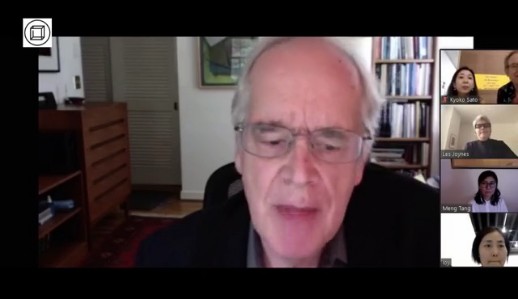
莱斯:
羅一,你能谈谈你选择狗的原因吗?
Les: Loy, could you talk about the reason that you choose the dogs?
羅一:
当我给狗狗拍照的时候,我感觉”这人”是如此真实,因为它们不用戴两个面具。他们自然生动。所以当我看着它们的时候,我想这是“我”,这是真正的“我”,但不是一个,因为每只狗都有很多张真实的脸,所以我想,人类也有很多真的“我”。从这一点上出发,我发现了另一件事:当我做别人的肖像时,我觉得每个人的肖像都是我的肖像。每个人,每条狗,每次为他人画像就是为自己画像。于是,我觉得“我I”回来了,因为散落在每一个客体里的主体是无处不在的。我想通过这件事(画像),我可以找到主体我I,正因为我在重新思考我有多少真实的客体我Me,主体我I才复苏了。
Loy: When I take pictures of dogs, I feel "the person" is so real, because they don't have to wear two masks. They are naturally lively. So when I look at them, I think this is “me”, this is the real “me”, every dog has a lot of real faces, so I think humans have a lot of real “me”. Proceeding from this, I have discovered another thing: when I do portraits of others, I feel that everyone's portrait is my portrait. When someone paints a portrait of someone else, he paints a portrait of his own. So, I feel that “I” is coming back, because the subject that is scattered in each object is everywhere. I think through this I can find the subject I, and it is because I am rethinking how much of the real “me” I have that the subject I is revived.
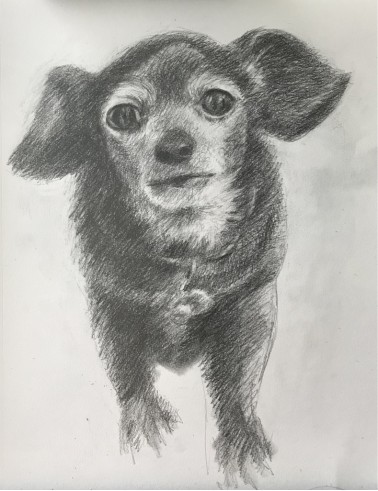
《小黑》 羅一 素描 11*14 英寸 2020年2月
Black Doggie LoyLuo Sketch 11”*14”2/2020
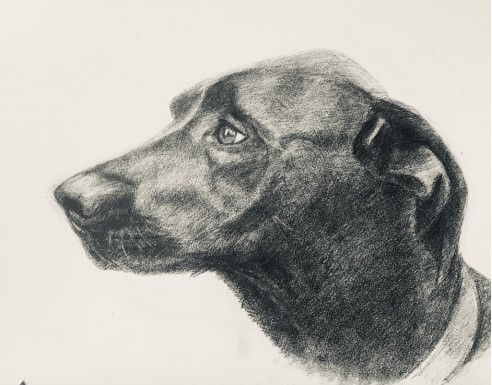
《大黑》 羅一 素描 11*14 英寸 2020年2月
Black Dog LoyLuo Sketch 11”*14”2/2020
莱斯:
羅一,我们在纽约都经历过这种情况,因为它的多样性。这里有很多遮蔽,如精神遮蔽在纽约,现在是双重遮蔽。比如之前你也提到的,如果你觉得街上有人拒绝你要求他们他们放下面具,你就说,我可以给你的狗狗拍照吗?在某种程度上,你表达了一种救援,因为能够看到一只狗的诚实和直接,这就是我在这里的感受。大卫,我相信你有评论。
Les: I think, Loy, we all experience that in New York because of its diversity. And there is a lot of masking, like spiritual masking in New York, also double masking now, and you mentioned before you felt that if somebody rejected your request to take their mask down on the street for example, you would then say, can I take a photograph of your dog? You express something that was like relief, in a way, because to be able to see the honesty and directness of a dog, that's what I feel is translated here. David, you had a comment I believe.
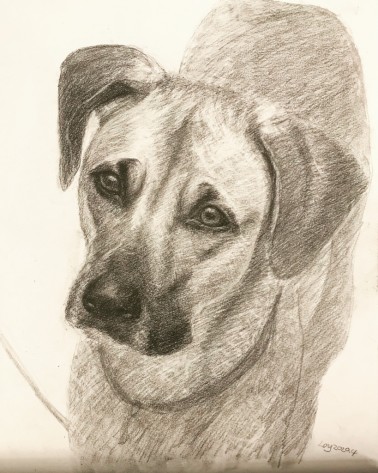
《大黄》 羅一 素描 11*14 英寸 2020年2月
Yellow Dog LoyLuo Sketch 11”*14”2/2020
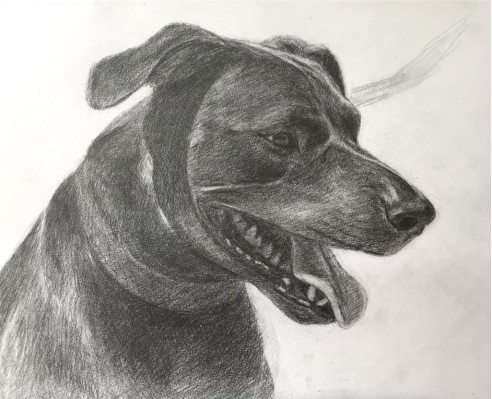
《老了》 羅一 素描 11*14 英寸 2020年2月
Old Dog LoyLuo Sketch 11”*14”2/2020
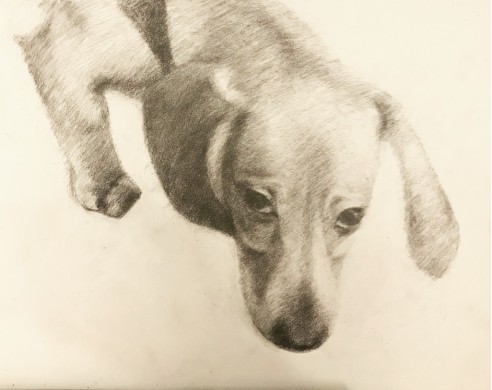
《小黄》 羅一 素描 11*14 英寸 2020年2月
Yellow Doggie LoyLuo Sketch 11”*14”2/2020
大卫:
我只是想补充一下,羅一说过的画画是如何把她和人们联系起来的。我想从策展人佐藤恭子那里听到更多。她在文章中写道,羅一的图像让人们走到了一起。羅一说,她看到她自己在她所创造的另一个人的形象里。就像是当她在看的时候,在画的时候,在与人交往的时候,她仿佛看到了她自己。佐藤恭子写道,她从别人的脸中看到了羅一。 一幅手绘的画让人们走到一起。我想知道他们俩是怎么想的。
David: I just want to add something that Loy said about the way making a drawing connects her with the person. I’d like to hear more from Kyoko Sato, the curator, who writes that Loy Luo’s images bring people together. Loy says she sees herself in the image of the other person that she is creating. It seems that she sees herself when she's looking, making a drawing, and also meeting people. And Kyoko Sato writes that she saw Loy in the image of someone else’s face; a drawing made by hand brings people together. I'm just wondering what both of them think about that.
恭子:
这是我关于她的肖像的想法。每当我看到肖像,我就会看到艺术家的脸。她一边画画,一边看着他们的脸,但她也在每张脸上寻找自己。
Kyoko: That is my idea, concept about her portraits. Whenever I see the portraits, I see the artist’s face. While she is making drawings, looking at their faces, but she is also looking for herself in each face.
安东尼:
约翰逊·阿萨德说肖像画是嘴巴有问题的画作。当我看这些画的时候,有一些东西深深地打动了我。大卫·德维恩(David Devein)曾多年为《纽约客》(New Yorker)的书籍画肖像,他的作品非常出色,还有来自布鲁克林铁路公司(Brooklyn Rail)的Phong Bui,他们倾向于选择一种被动的形象,不是完全没有表情,但没有鲜明的个性。你不必过分夸张,没有什么能完全与它们相比,但它们有各种各样的表达方式,我认为这是这些个人绘画的全部特征。我想知道关于选择图像用以制作你的绘画你是怎么说的。
Anthony: Johnson Assad said portraits are paintings with something wrong with the mouth. When I look at the drawings, something struck me very much. David Devein, who did drawing portraits for New Yorker books for many years and brilliantly, or Phong Bui from Brooklyn Rail, they tend to go for a passive look, not exactly expressionless, but not radiating personality. You don't overdo, nothing compares purely about them, but there are a wide variety of expressions, and I assume it was thoroughly characteristic of the personal drawings. I’d like to know what you said about choosing the images from which you made your drawings.
羅一:
有时候当我在街上行走时看到对面走来的人会突然留下深刻的印象,也许是触动了某种联想(比如一个古罗马的长老或斗兽场的胜者)。这是我最喜欢的选择。当然,对于一些人来说,一开始我找不到什么感觉,也许因为看起来很正常,他们会让我画肖像。比如当我住在酒店,坐在青年旅社的公共活动空间日复一日地画画,很多人会说“哦,你真有才华,你能帮我画一幅肖像吗?”然后,当我遇到一些不那么令人印象深刻的面孔时,我会试着寻找一个非常特别的时刻,我从很多照片中选择其中一个看上去很有精神性的时刻。几乎绝大多数人我都能找到一个很好的时刻,但有时,一些人可能面具太多我很难探触到他们更深层的精神性,所以当我遇到这种情况时,我不能做得很好。
Loy: Sometimes when I was walking down the street and seeing someone coming across the street suddenly I got a deep impression, perhaps a connection (like an ancient Roman patriarch or the winner of the Colosseum). This is my favorite choice. Of course, for some people, I don't feel anything at first, maybe because it looks normal, they ask me to do portraits. For example, when I was staying in a hotel, And I was sitting in the public space of a youth hostel and I was painting day after day, a lot of people would say, "Oh, you're so talented, can you do a portrait for me?" Then, when I come across some of the less impressive faces, I try to find a very special moment, and I choose one of many photos that looks very spiritual. Almost most people I can find a good moment, but sometimes, some people may have too many masks and It's hard for me to get into their deeper spirituality, so I can't do that well when I'm in a situation like this.
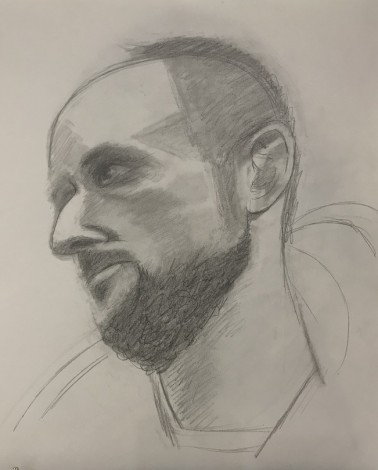
《地铁乘客》羅一 速写11*14 英寸 2020年8月
Passenger on Subway Loy Luo sketch 11”*14”8/2020
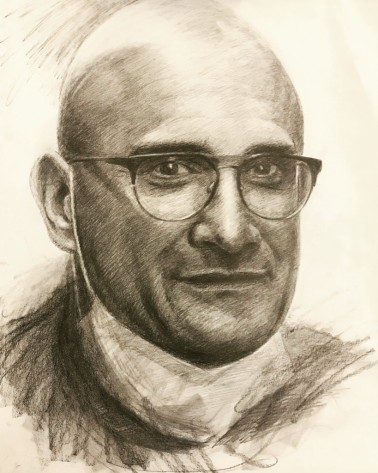
《旅馆经理》羅一 素描11*14 英寸 2020年5月
Hotel Manager Loy Luo sketch 11”*14”5/2020
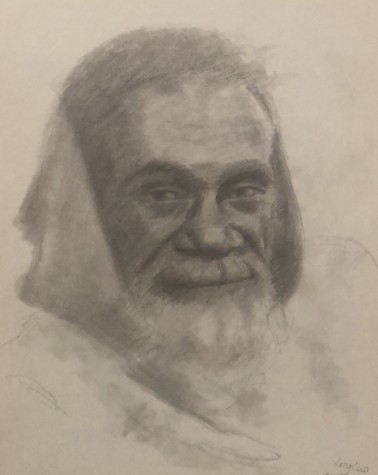
《无家可归者》羅一 素描11*14 英寸 2020年8月
Homeless Loy Luo sketch 11”*14”8/2020
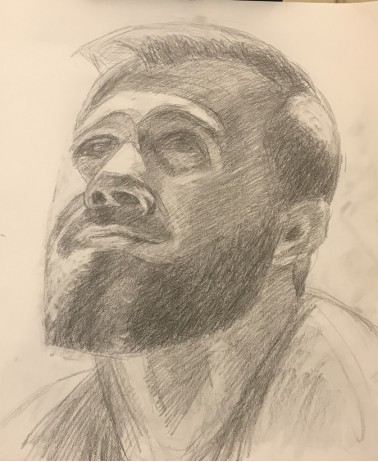
《工地包工头》羅一 速写11*14 英寸 2020年6月
Construction foreman Loy Luo sketch 11”*14”6/2020
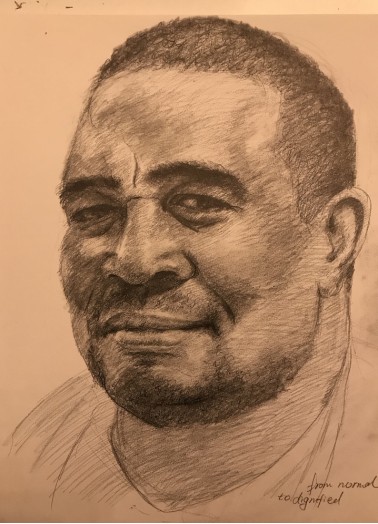
《电影编辑》羅一 素描11*14 英寸 2020年3月
Film Editor Loy Luo sketch 11”*14”3/2020
莱斯:
我真的很欣赏你的肖像画,因为有些东西打破了我的障碍,就像我在看一幅旨在写实的画,我们会被吸引到那个空间就像我们在看电影,就像被困在一个电影的空间里,有一种刺穿第四堵墙的感觉。我想说的是在我们正在看的每一幅画中,比如现在我们眼里最上面中间的这幅,有一种视觉连接,也许是因为绘图的速度,有了情感的东西, 而这同样是你的选择,他们是不现实的, 但这种方式,使他们更充满活力。我感兴趣的一些20世纪90年代英美当代艺术家中的一位,画出了一些奇怪的画,有点不正常,有点奇怪。我们再看这些肖像照片,例如,这里有个三人肖像,有两个人以同一种方式在看,然后第三个人看上去像在不同的维度上,看起来有点奇怪。所以你把我们带进来,让我们看到有一些不可思议的东西,一些奇怪的东西,对我来说这很有趣。
Les: I really appreciate your portraits because there’s something that breaks the barrier with me, almost like we look at a painting that's aiming to be realistic. We will be captured into that space almost like we're watching a movie. We get caught in a cinematic space, and there's something about piercing the Fourth Wall. I would say that in each of these, we've got the drawing, the top centered drawing that we are looking at right now, there's a sense of visual connection, and then also your choices to create, maybe in the quickness of the drawing, there's something that captures something emotional where they are not realistic, but in that way where they are more vibrant. One of many artists that I’ve been interested in, some contemporary artists in the 1990s in UK and the United States, create curious drawings that will be a little bit off, something a little bit strange. When we look at some of these photographs we have in the portraits of these three people for example, we have two people that are looking in one way and then have the third person looking a little bit strangely in a different dimension. So you kind of bring us in and there's something uncanny, something strange, which is interesting to me.
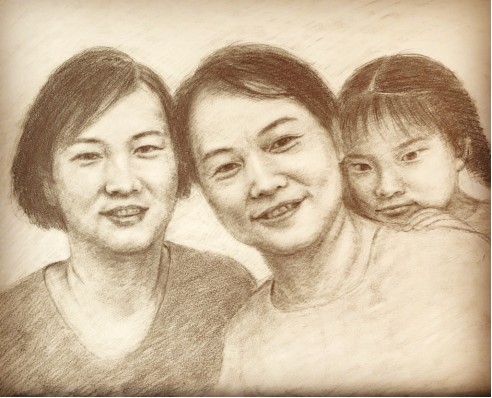
《付小华和她的家人》羅一 素描11*14 英寸 2020年4月
Xiaohua Fu and Her Family Loy Luo sketch 11”*14”4/2020
羅一:
对我来说,我不光是为了像照片里的人而做肖像。当然,我使用图片来帮助我抓住一些东西,但不只为了它看起来像或不像那个人。这不是我想要的。在我画肖像画之前,我有很多年没有画过肖像画。只是当我来到纽约并陷入疫情时,我才觉得这么多的面孔是如此有趣,如此生动,如此多的欲望,所以我觉得它非常有趣,它吸引了我。在我做这个之前,我专注于抽象绘画和雕塑很多年因为我没有生活在现实生活中;我一直生活在,也许,天空中。我对现实生活不感兴趣,我觉得我的大部分精力都在哲学上,如果是西方哲学,我可以读一本非常大的哲学词典很多很多个日日夜夜。但是当我来到纽约的时候,我想,是的,当然我的家庭也发生了一些事情,所以我想我从天上来到了地球,来到了现实生活中,这一切都很好。在纽约,当代艺术家总是说“你的艺术可以融入生活”,我说“好吧”。现在,我回到现实生活,就像这样,不去思考形而上学的问题。
Loy: For me, I don't just do portraits to look like people in pictures. Of course, I use pictures to help me catch something, but not just to make it look like or not like that person. That's not what I want. I hadn't painted a portrait for years before I painted a portrait. It was only when I came to New York and got caught up in the epidemic that I found so many faces so interesting, so vivid, so much desire, that I found it so interesting, and it caught me. Before I did this, I concentrated on abstract painting and sculpture for many years because I didn't live in real life; I've been living, perhaps, in the sky. I'm not interested in real life, I think most of my energy is in philosophy, and if it's western philosophy, I could read a very big philosophical dictionary many, many days and nights. But when I came to New York, I thought, yes, of course something happened to my family, so I think I've come from the sky to the earth, to real life, and it's all good. In New York, contemporary artists always say, "Your art can be integrated into your life," and I say, "OK." Now, I go back to real life, like this, and I don't think about metaphysics.
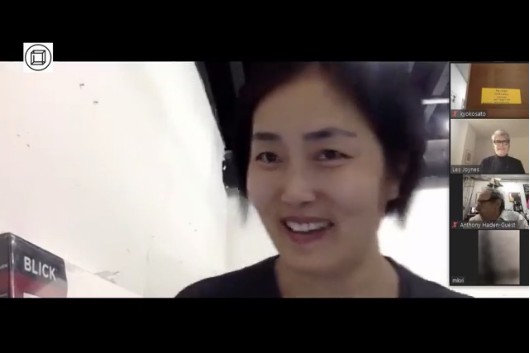
莱斯:
我可以请唐梦或殷梅来评论一下吗?
Les: Could I ask just a comment please from either Meng Tang or Yin Mei?
唐梦:
几年前我第一次见到羅一的时候,她主要以她的抽象画而闻名。这次我看到了许多画像。这让我想起了德国摄影师奥古斯特·桑德。奥古斯特·桑德(August Sander)是一名摄影师,在第一次世界大战和第二次世界大战期间为普通德国人拍摄身份证照片。当他拍摄这些肖像时,他可能不认为这些肖像是如此引人注目。今天通过这些影像,我们可以强烈地感受到他抓住了那个时代的面孔,有力地记录了德国社会普通人的感受。羅一的作品给了我同样的感觉。当你单独看每一幅作品时,你会看到许多很好的肖像,以特定的方式捕捉人们的身体和精神。但是当你看到数以百计的人,你开始感觉到一些别的东西,一些更大的东西——在疾病大流行期间纽约人和所有美国人的集体意识——不管种族,民族,文化背景,有一些东西是他们共同的,他们对生活的感觉。
作为一个爱狗人士,我对那些狗的肖像很着迷。如你所知,狗知道关于爱的谎言。他们从不谎报自己的感受。他们总是通过他们的眼睛和肢体语言来表达他们的真实感受。当你看着狗的眼睛,你看到了它的精神,你知道狗和人是平等的。羅一在捕捉狗的情感和精神方面做得很好。
羅一最近的作品展现了大流行期间纽约市的真实面貌。这些作品非常引人注目。
Meng : When I first met Loy a couple of years ago, she was known mostly for her abstract paintings. This time I saw many portraits. These portraits remind me of German photographer August Sander. August Sander was a photographer and took identity card portraits for ordinary German people between World War I and World War II. When he did those portraits, he might not think those portraits are so compelling. Today through these images, we can strongly feel that he caught the face of the time and powerfully recorded German society's ordinary people’s feeling. Loy’s work gives me the same feeling. When you see each work individually, you see many good portraits that catching people's body and spirit in particular ways. But when you see hundreds of them, you began to feel these is something else, something much bigger – the collective consciousness of New Yorkers and all Americans during the pandemic - no matter race, ethnicity, cultural background, there is something they all share and they all feel about life.
As a dog lover, I am fascinated by those dog portraits. As you know, dogs know lie about love. They never lie about their feelings. They always express their true feelings through their eyes and body language. When you look at a dog in its eyes, you see its spirit, and you know dogs are equal to human beings. Loy did very well in capturing dogs’ feelings and spirits.
Loy’s recent works generate a genuine picture of New York City during the pandemic. These works are very compelling.
殷梅:
我要说几句。事实上,唐梦提到的第一点就在我的笔记中。作为一个编舞,当我看到这些画的时候,当然每个人都很美,这是一幅很美的肖像,它们在某种程度上非常现实,但在另一方面,就像安东尼说的,它们对我来说是后现代的。你看不见背景,看不见它们从哪里来,你只看到,你完全被那个时刻的人的精神所吸引。当羅一Loy谈到面具的时候,我的理解是,一个灵魂是没有面具的,但是我们作为人,我们总是试图把自己层层遮盖起来,透过面具看事情,我们通过面具展现自己。但作为一名艺术家,我们的工作就是试图揭示隐藏在那里的真相,我强烈地感觉到这些画,来自它们的力量,就是重复。所以,作为一个编舞,当我们工作的时候,你创造了一个短语,但是如果这个短语重复十次,一百次,这个动作就变成了别的东西。所以在这里我认识到这种力量。当然,这是一个流行的时期,但对我来说,他们是人类,所以我完全忘记了大流行,或纽约,我甚至不认为这是在纽约,但这是人类,这就是人性,这是带来光明的人。即使此刻我们所有人都在这场大流行中,这也是人类的精神,通过工作所发出的光芒,我认为是非常强大和鼓舞人心的。这就是我对作品的回应。
Yin Mei: I'm gonna say few words. Actually, the first point when Meng Tang talked about, it is right in my note. As a choreographer when I see these paintings, of course every individual portrait is a beautiful portrait, from any point of view. They are in one way realistic, but in another way, like Anthony, they are post-modern to me. You do not see the background in the portrait, you do not see where they’re coming from, you only feel, you are totally captured, by the spirit of the person at that moment. I think that when Loy talked about the masks; my understanding, a spirit has no mask, its connected to Oneness, therefore, no nothing needed. But people do, people always try to cover in layers and not to let others see things through, we present ourselves through masks. Artist often has intention and ability to try to reveal what is beyond the masks and to touch the truth lying beneath, and I feel this very strong intention came through these paintings. Moved me also very much is the immersive power of repetition. As a choreographer, the space is always capturing us and what is moving in that space and how which create the energy and emotions. A movement phrase repeated ten times, hundred times, the movement articulate something else, which becoming something you never recognized before. So here I recognize this power, which bring the viewer immerse with her portraits. At this moment of pandemic, the portrait stood out so human that I forget time and space, and the pandemic, nor New York, I don't even feel this is in New York, those human beings could be in anywhere, she portrait the true sense of humanity, she brought the light from those people. the human spirit, the light shining out through the work which I think is totally powerful and inspirational. This is my first reaction to the works.
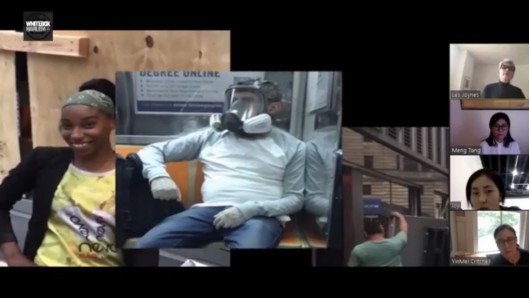
莱斯
非常感谢你,殷梅。目前在中国的王春辰刚刚在这里通过短信发表了评论,我将朗读他的评论:“羅一的肖像画很有趣。例如,它们让我们思考人们在面对大流行时如何看待自己的脸。有一种捕捉脸部的感觉,捕捉亲密性以及面具后真实的人的感觉。与此同时,这是纽约,作为它的一部分,这里有一种乐观的感觉,至少当我出去的时候,我感觉到,所以他们面对流行病,有一种坚定的感觉。即使是在大流行病中,他们也能获得积极的一面,这是一种力量。
此外,春辰说:“这些画像让我们重新思考什么是全球化以及人们如何相互依赖。“我认为这是一个非常有趣的评论,尤其是这些作品是一个来自中国的艺术家和纽约市民之间的对话。”所以我想问一下羅一,她是否能对此发表评论。
Les: Thank you very much Yin Mei. And Chunchen Wang, who is now in China, has just made a comment here by text, which I'll read out: “Loy’s portraits are interesting. They make us think about how people look at their own faces, when facing the Pandemic, for example. There is a sense of capturing the face, capturing the intimate, real person behind the mask. At the same time, this is New York, as part of it there is a sense of optimism, at least I feel it when I go out, so that they are facing the Pandemic and there is a sense of resoluteness. There is sense of strength in the way they can access a positive side, even in a pandemic.
And also, Chunchen says “these portraits make us reconsider what is globalization and how people depend on each other.” I think that's a very interesting comment especially about these works has being a dialogue between an artist from China with people in the city of New York. So I'd like to ask Loy if she could comment on that.
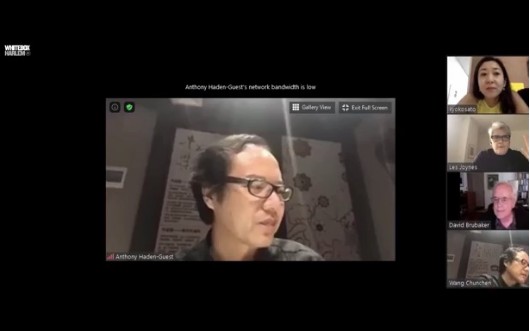
羅一:
我很高兴。我记得上次Les问过我关于重戴面具的问题。同时我也想回答殷梅刚才讲的内容。她说我们是社会人,当然要戴面具。我同意,我也正是这么想的。恭子,请你打开我的网站www.loyluo.art最后一个帖子好吗?我写了一些关于这个问题的东西。
这一部分是在思考个人面具,为什么我们应该放下面具,因为我们需要回到“我I”,从“我ME”回到“我I”,找回真正的“我I”。下面部分是我反向思考面具的积极意义,即在大流行中不仅有形的面具很重要,我们也应该考虑精神面具的积极意义,而不只是以批判的态度对待它,我们可以思考精神面具可能有它存在的理由。
Loy: I'm very happy. I remember last time Les asked me about putting on the mask again. At the same time, I also want to answer what Yin Mei has just said. She said we were social beings and of course we had to wear masks. I agree. That's what I was thinking. Kyoko, will you please open the last post on my website www.loyluo.art? I wrote something about this problem.
This part is thinking about the personal mask, why we should put down the mask, because we need to go back to "I",from “me” to “I”, and recover the real ‘I”.
The following part is my reverse thinking about the positive meaning of the mask, that not only the physical mask is important in the pandemic, but we should also consider the positive meaning of the spiritual mask, and not just treat it critically, we can think about the reason that the spiritual mask may have its existence.
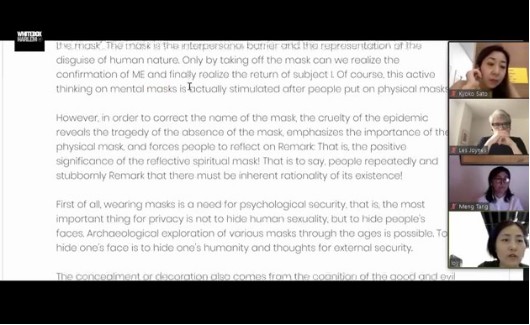
莱斯:
我想感谢你创造了一个非凡的空间的想法。通过一个独特的人类空间来理解身份。你正在接近纽约人,作为一个来自另一个国家的旅行者,你在自己和他们之间架起了一座桥梁——一座连接你和他们的桥梁。这些画的创作是你将“我”投射到他人身上,并通过他人创造出一种自我感觉的一部分。王春辰评论说,若我们有未来,羅一的画像告诉我们如何面对未来。这样说,有一种乐观和人性的感觉。
Les: I'd like to acknowledge the idea of your creating a remarkable space. And understanding identity through a space that is uniquely human. You are accessing the human in New York,. You are creating a bridge between yourself, as a traveller from another another country - a bridge and a connection between you and them. The creation of the drawings is part of your projecting your “I” into the other person and creating a sense of yourself through the other person. Chunchen Wang comments that Loy’s portraits show us how we face our future, if we have a future. By saying that, there is a sense of optimism and humanity.
唐梦:
羅一说纽约是个令人兴奋的地方。生活在这个城市,认识这些人,和他们一起工作,通过她的肖像记录他们,羅一开始了解他们,并觉得每个人的人性都是一样的,尽管纽约是一个非常多样化的地方。但在认识他们之后,她认为所有的人都很相似。
Meng: She said that New York City is an exciting place. Living in the city, knowing those people, working with them, and recording them through her portraits, Loy started to understand them and feel that the humanity is the same in everyone, even though New York is a very diverse place. But after knowing them in person, she thinks that all human beings are very similar.
羅一:
我想说,当我来到纽约时,我遇到了很多非常贫穷的人、无家可归的人,我和他们交谈。然后我去非常富有的人的公寓,我知道他们不想取下他们的面具,他们宁愿我为他们的狗画肖像。我认为这些肖像不仅仅是看肖像本身,我还做了一些其他的事情,包括写作和做视频。我把我的想法也放在了视频里。我想这些一块儿组成我对纽约人的看法。
Loy: I would say that when I came to New York, I met a lot of poor people, homeless people, and I talked to them. Then I go to the apartments of very rich people, and I know they don't want to take off their masks, they'd rather I do portraits of their dogs. I think these portraits don't just look at the portraits themselves. I also did a few other things, including writing and making videos. I put my thoughts on the video as well. I think that's what makes me think about New Yorkers.
莱斯:
肖像有两种形式,一种是个人的肖像,另一种是“我”的肖像——羅一在纽约的“我”。你把自己放在了肖像画里。当我看这些视频的时候它们以一种方式呈现给我一种我正在倒塌的感觉,所以在倒塌的时候观看纽约,是这些多频道视频中一个有趣的视角。同样感谢唐梦和殷梅Yin Mei的澄清。克里斯托弗,你能分享一下成为纽约的主角是什么感觉吗?
Les: You got two forms of portraits, one is the portraits of individuals, the other is the portraits of the “I” - Loy’s “I” in New York. And, you are putting yourself in the portraits. When I’m watching these videos they are presented in a way that gives me the sense that I am falling down a building, so the idea of watching New York, while falling, is an interesting perspective in these multi channeled videos. Thank you Meng Tang and Yin Mei for your clarifications there as well. And Christopher, could you share what is like to be the subject, a New York subject?

克里斯托弗:
当然可以。首先感谢恭子邀请我参加,还有羅一,很高兴再次在这里见到你。很高兴认识大家。我在白盒子艺术中心偶然遇见了羅一,我不知道她会在那里。我很快就意识到我们在做同样的事情,尽管我不是一个视觉艺术家。我是一个名为“记忆与分享中心”(center for Remembering and Sharing)的康复与艺术中心的主管,我还是一个苏菲派舞者,一个表演艺术家。我的感觉是羅一只是想让我们永远记住我们是一个整体,记住我们每个人身上都有光和爱。她有意让我们记住我们是不同的,直到她意识到或经历了一些超越的事情。你知道,我们一直都有这样的想法。我看见你在那边。她画了所有这些不同的图像,但想要超越这些。因为她让我感到非常安全。我觉得我很乐意和她一起表达自己,和她打招呼,所以我认为她能画下这么多人的脸的原因是,你知道,他们的脸都亮了起来,这始于这个意图。她想一次又一次地经历这种经历,这样人们就能认出来。她允许这种情况发生。我不觉得她把自己投射到我身上,但我们之间的障碍正在融化。当她画我的时候,我并不知道她在画我。她邀请我在她的开幕式上表演苏菲派舞蹈。关于苏菲舞,我能说的是,我试着敞开自己,接受一切,让宇宙的爱进入我的内心,或者只是意识到它已经在那里,消除阻碍它回流的障碍。所以她也是一样的。我试着与她融为一体,因为我不停地旋转,直到有一些平静,在所有的骚动、情绪和眩晕中有某种内在的东西。直到后来我才知道她在给我画素描。我很惊讶她抓住了我,还有她描绘我肖像的方式,但也许并不惊讶,因为我觉得她就是这样的人。因为她真的是一个好奇、有爱、开放的人,她给我们空间向她表达这些。
Christopher:Sure. First of all, Kyoko, thank you for inviting me to participate, and Loy, it is wonderful to see you again here. It’s nice to meet all of you. I met Loy by chance when I was at White Box and I didn’t know she would be there. I really quickly felt or recognized that we are doing the very same thing, although I’m not a visual artist. I’m a director of a healing and art center called Center for Remembering and Sharing, and a Sufi dancer, and a performing artist. What I felt is that Loy just wants us to remember all the time that we are one, that there is light and love in each of us. She has an intention to remember to allow her thoughts that we are different to drop, until she recognizes or experiences something beyond that. We have these thoughts all the time, you know. I see you over there. She is drawing all these different images, but wants to go beyond that. Because I could feel that in her I feel very safe. I feel very welcome to allow something more of myself to express itself with her, to say hello back, so I think the reason she is able to capture so many people with their faces just, you know, lighting up, it starts with that intention. She’d like to have this experience over and over again and people can recognize it. She allows that to happen. I don’t feel that she is projecting herself into me per say, but just whatever barrier is between us is melting. When she drew me, I didn’t actually know that she was drawing me. She invited me to do a Sufi dance at her opening. What I could say about the Sufi dance is that I’m trying to open myself to receive everything, to allow all the love of the universe to come into me or just to be aware of it already there, to dissolve the barrier to it flowing back out. So it is also the same thing. I’m trying to melt with her, as I’m spinning around and around until there is some stillness, something internal there through all the commotion and emotion and the dizziness. I didn’t know till afterwards that she was sketching me. I was so amazed that she caught me and also how she depicted my portrait, but maybe not surprised, because that is who she is, I felt. Because she is really a curious, loving, open person, she allows us space to express that back to her.
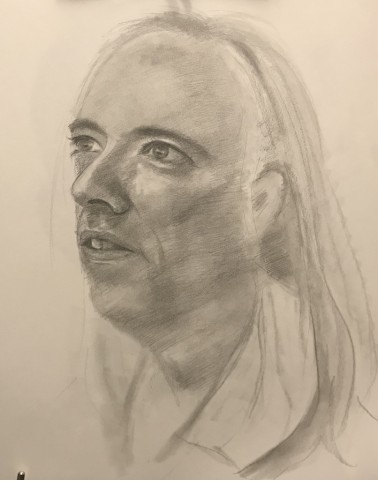
《克里斯托弗·佩勒姆》羅一 速写11*14 英寸 2020年7月
Christopher Pelham Loy Luo sketch 11”*14”7/2020
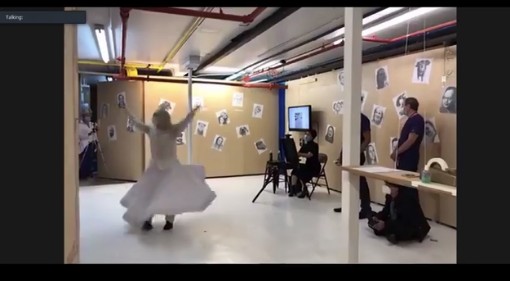
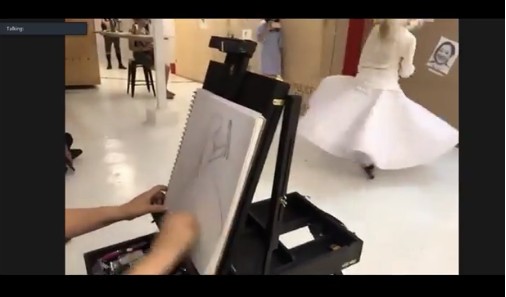
莱斯:
克里斯托弗,我认为你说得很好。因为,从这些经历中,你感受到一种联系的感觉,而你是一名苏菲派舞者,被羅一邀请来通过舞蹈和表演创造一种普遍的联系,从而对展览有所加强。你在这方面的经历更像是一种纯粹的能量,让你明白为什么在艺术创作的当下,艺术是如此独特和鲜活。
我记得我在伦敦圣马丁艺术学院读艺术第一年的时候,我曾经问过我的一位老师,我们是否应该做一些看起来像我们在博物馆里看到的东西那样的艺术品。他说,做一些发自内心的东西比仅仅看起来像艺术的东西要好。正是我们赋予作品联系的那一刻让艺术作品充满了生命力。我认为重要的是我们可以看到和感受到艺术家和主题之间的连接时刻。
我们可以从羅一作品中的“我”中看到这种联系感。我们可以看到一种笨拙的感觉,也可以看到它并没有试图成为其他任何东西,除了那种联系。把艺术货币化的想法,做适合博物馆的艺术,做迎合批评家的艺术,做强迫艺术家的艺术,不是强迫,而是诱惑艺术家成为另一个人,成为其他体系的代理人。
羅一来到纽约。她简单地说,我要创作一些画作,不必要进入其他系统,它们与政治无关,也与博物馆展览无关,而是与联系的需要有关。羅一,你能对此发表一下评论吗?
Les: Christopher, I think you beautifully said that. Because, from the experience, you felt a sense of connection, and you are a Sufi dancer invited by Loy to enhance the exhibition by creating a universal connection through dance and performance. Your experiences of this was more of a pure energy of why art, at the moment of art making, is so unique and alive.
I remember in my first year of art school at St. Martins in London I once asked one of my teachers if we should make artwork that looks like the stuff that we see in museums. He said that it is better to make something that comes from the heart than something that merely looks like art. And it's that moment of connection that we give to the works is what makes the artwork alive. I think it is important that we can see and feel the moment of connection between the artist and the subjects.
We can see that sense of connections in the “I”s in Luo’s work. We can see a sense of awkwardness and also see that it's not trying to become anything else other than that connection. The idea of monetizing art, making art that fits the museum, art that fits the criticism, making art that is forcing the artists, well not forcing, but enticing the artist to become that other person, the agent of the other systems.
And that Loy comes to New York and says simply I am going to create drawings that don't have to get into these other systems, they are not about politics, they are not about having a museum show, but it's about the need for connection. So, Loy, could you make a comment on that, please?
羅一:
是的,我想这个行为让我和这个城市之间发生了非常大、非常好的联系。因为我不能来到纽约后只是呆在屋子里或工作室里做自己的事情,我也需要社会联系。尤其是在大流行中,每个人都很恐慌。虽然我也恐慌,但每个人都恐慌。这是一个方面。还有另一个原因就是艺术家的社会责任,作为一个艺术家做一些事情是非常重要的。我认为,很多好的艺术家在遇到重大事件时总想为社会做点什么。
Loy:Yes, I think it made a very big and good connection between me and the city. Because I can't come to New York and just stay in the house or the studio and do my own thing, I also need social connections. Especially in a pandemic, everyone is panicking. I panicked, too, but everyone panicked. That's one thing. There is another reason is the social responsibility of the artist, as an artist to do something is very important. In my opinion, many good artists always want to do something for the society when they meet important events.
莱斯:
羅一,你能告诉我你画的大部分画是在哪里找到的吗?纽约的什么地方?
Les: Can you tell me, Loy, where did you find most of the art that you drew? Where in New York?
羅一:
前两个人来自微信,我只是觉得那照片很有趣。然后是其他人,比如Juan,我认识他,当我给他看我的作品时,他说:“哦,你可以画我”,这是第一次纽约人请我画像。后来我住在旅馆里,旅馆有很大的公共空间,我可以坐在那里画肖像,那里有很多来自其他国家的人,当我坐在那里画肖像的时候,陆续有人请我给他们画。但大流行爆发后,我们被扫地出门。旅社关门,所以我需要到街上去见一些人。我说"你想画肖像吗?“就这样,不容易,但多么有趣。我认为我画的每个人都有一个非常有趣的故事。
Loy: The two guys I drew at first are from WeChat, and I just thought the photo was funny. And then there are other people, like Juan, who I know, and when I showed him my work, he said, "Oh, you can paint me." It was the first time a New Yorker asked me to paint him. Then I stayed in the hotel, which had a lot of public space where I could sit and do portraits, and there were people from other countries, and as I sat there, people started asking me to do portraits. But when the pandemic broke out, we were thrown out the door. The hostel is closed, so I need to meet some people on the street. I said, "Do you want to do a portrait? "That's it. It's not easy, but it's fun. I think everyone I draw has a very interesting story.
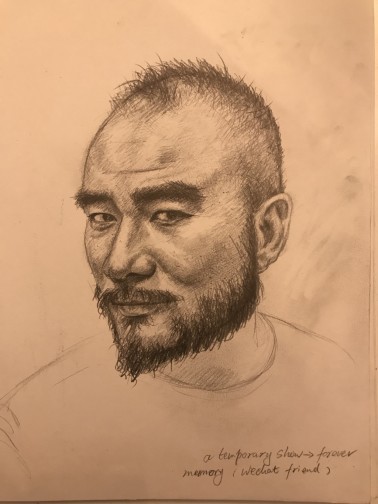
《王锐》羅一 素描 11*14 英寸 2020年2月
Rui Wang Loy Luo sketch 11”*14”2/2020
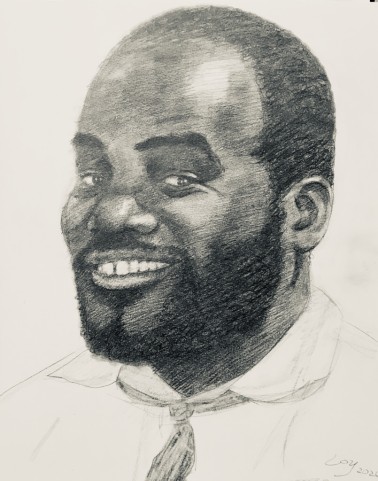
《公寓经理》羅一 素描11*14 英寸 2020年3月
Apartment Manager Loy Luo sketch 11”*14”3/2020
莱斯:
谢谢。我想安东尼想说点什么,现在轮到你了,安东尼。谢谢你的评论。
Les: Thank you. I think Anthony would like to make an observation, so over to you, Anthony. Thank you for your comment.
安东尼:
嗨,你好。这是观察的问题。大多数艺术家,几乎所有的艺术家,当他们用钢笔或铅笔工作时,发展出一种强烈的签名风格,立即被识别。你的肖像都是明显的你,你的手都能认出它们。你有各种各样的铅笔处理,包括颜色,光和暗,以及铅笔的实际处理。我想知道你选择的主题是否影响了他们的性格?这就是我的问题。
Anthony: Hi, hello. Its a question of observation. Most artists, almost all artists, when they work with pen or pencil, develop a strong signature style which is instantly recognizable. Your portraits are all obviously you that your own hands recognize them. You have a pretty wide variety of pencil treatments, both in coloration, the lights and dark, and actual treatment of the pencil. I wonder if that dictated by the subjects you choose impacted over their character? That is my question.
羅一:
这是我认为很重要的事情,因为我觉得我们都在强调艺术要完全遵从艺术家的内心,但我认为肖像是不同的,因为画肖像不仅是艺术家自己的事,它还是相互的,你需要与其他灵魂交流,而不只是你自己的灵魂。如果我不做肖像,如果我做其他纯艺术,也许我可以做任何我自己决定的事情,但是做肖像,我需要尊重人,因为他们和我是平等的,我需要尊重每个人。
Loy: This is something that I think is very important because I think we're all emphasizing that art is completely in the artist's heart, but I think portraits are different because painting portraits is not just the artist's business, it's mutual, and you need to communicate with other souls, not just your own. If I don't do portraits, if I do other pure art, maybe I can do whatever I decide on my own, but when I do portraits, I need to respect people, because they are my equals, and I need to respect everyone.
唐梦:
她的意思是她选择了一种特殊的方法来描绘每个人。她不想保持同一种风格,她用不同的风格来塑造不同的人物。
她不想让人们看到这些肖像出自同一位艺术家之手,因为她真的尊重每一位艺术家。所以,她想以独特的方式描绘这些人。她使用不同的风格和铅笔,所以笔画很不一样。
Meng: She meant that she chose a particular method to depict each person. She doesn’t want to stay in the same style, she uses a variety of styles for different figures she wants to portray.
She doesn’t want people to see that the portraits come from the same artist, because she really respects each individual. So, she wants to depict these people in unique ways. She uses different styles and pencils so that the strokes are quite different.
羅一:
但这不是我故意的,我只是做了,我不知道为什么风格会有不同。我不去想风格我只是去做。
Loy: But I didn't do it on purpose, I just did it, And I don't know why the style is different. I don't think about style, I just do it.
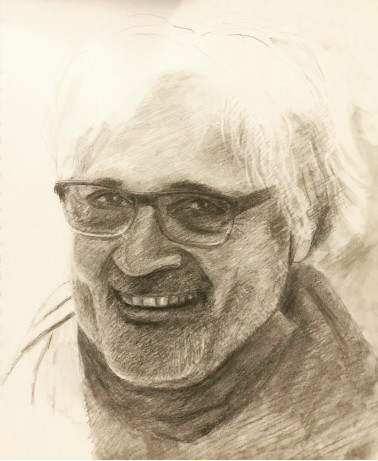
《金融业高管》羅一 素描11*14 英寸 2020年8月
Finance Executive Loy Luo sketch 11”*14”8/2020
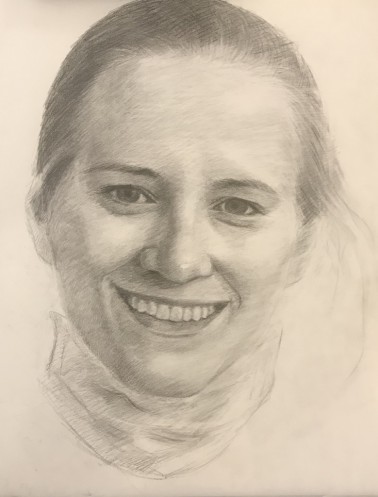
《护士》羅一 素描 11*14 英寸 2020年8月
The Nurse Loy Luo sketch 11”*14”8/2020
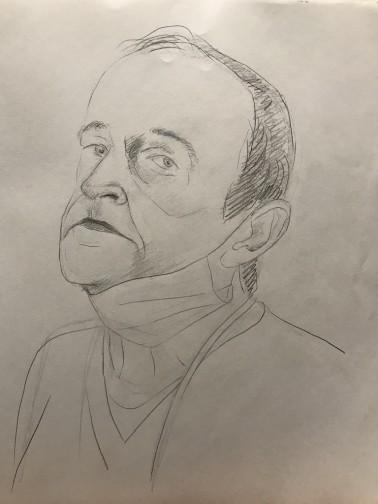
《医护人员》羅一 速写11*14 英寸 2020年8月
The Medic Loy Luo sketch 11”*14”8/2020
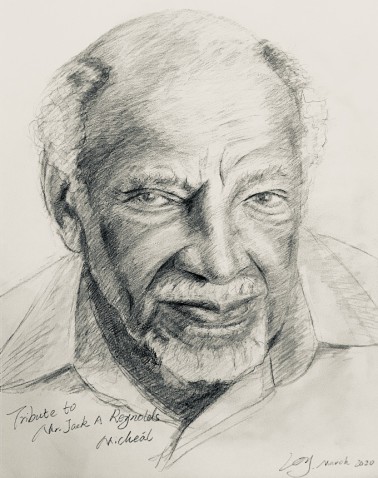
《老者》羅一 素描 11*14 英寸 2020年8月
The Old Loy Luo sketch 11”*14”8/2020
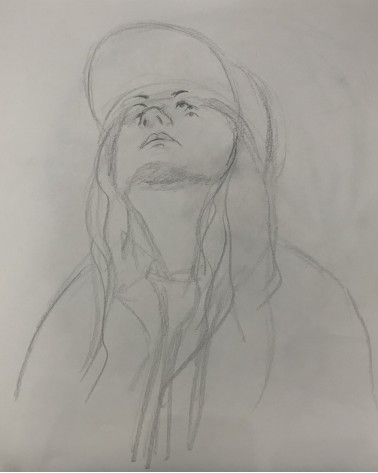
《地铁乘客》羅一 速写11*14 英寸 2020年8月
Passenger on Subway Loy Luo sketch 11”*14”8/2020
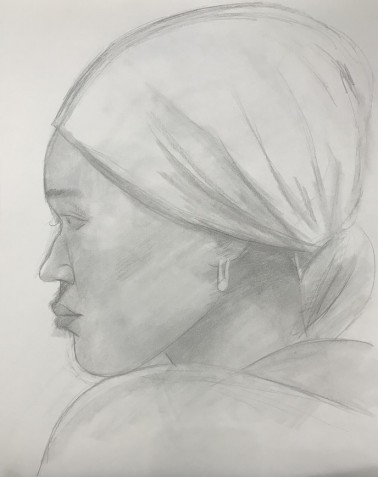
《看展的人》羅一 速写11*14 英寸 2020年8月
Spectator Loy Luo sketch 11”*14”8/2020
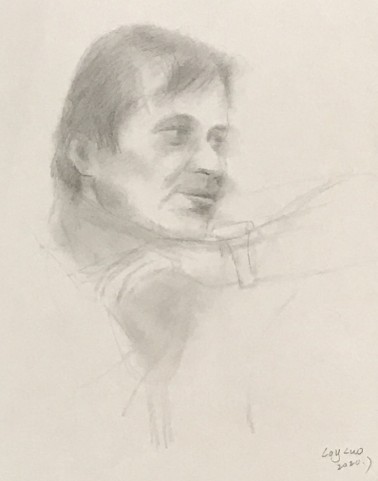
《饭店老板》羅一 速写11*14 英寸 2020年8月
Restauranteur Loy Luo sketch 11”*14”8/2020
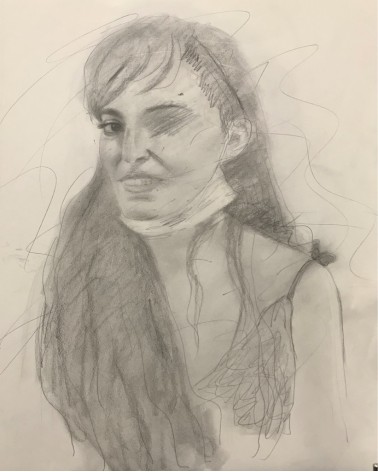
《舞者》羅一 素描11*14 英寸 2020年8月
Dancer Loy Luo sketch 11”*14”8/2020
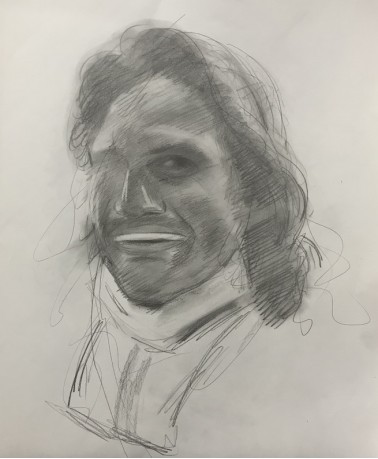
《工程师》羅一 素描11*14 英寸 2020年9月
Engineer Loy Luo sketch 11”*14”9/2020

《陈老宇》羅一 素描11*14 英寸 2020年8月
Laoyu Chen Loy Luo sketch 11”*14”8/2020
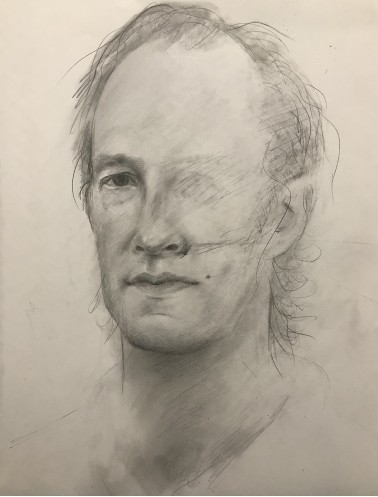
《面具》羅一 素描 11*14 英寸 2020年8月
The Mask Loy Luo sketch 11”*14”8/2020
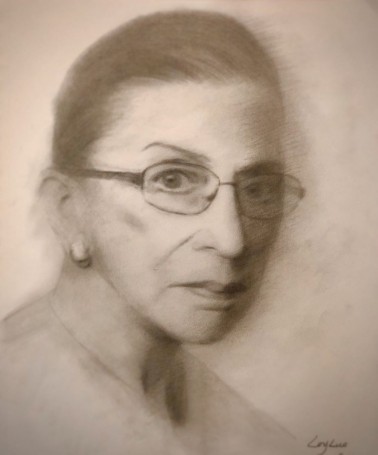
《大法官金斯伯格》羅一 素描 11*14 英寸 2020年9月
Judge Ginsburg Loy Luo sketch 11”*14”9/2020
莱斯:
殷梅,你能谈谈艺术家的观点吗?即作为一名大流行中的艺术家,你认为作为一名艺术家意味着什么?
Les: Yin Mei, could you speak about the artist’s point of view, being an artist in the Pandemic, and your own observations about what it means being an artist in the Pandemic?
殷梅:
谢谢你,莱斯教授,谢谢。作为一个艺术家,一个在纽约工作的艺术家,所有的场所都被关闭了。我们基本上呆在家里,当然也在网上授课,做所有的创造性工作,我的意思是,在家里做准备工作。但现在,我们开始,作为一个艺术家,所有的舞者都以这样或那样的方式聚集在一起,把他们的作品放到网上,展示他们以前的作品,对我自己来说,我在回顾我以前的作品,重新思考我的表现。这只是一个例子,许多其他艺术家,我的同事,也在网上创作他们的作品。
舞者们在家里搭建地板,这样他们就可以锻炼身体了。我认为这是一个美好的时刻,因为我们所处的形势。你可以抱怨,但最好的办法是节约你的精力,去创造。给你时间和空间去重新思考,就像羅一Loy正在做的一样,她正在积极地做肖像,而我们,作为一个艺术家,我们中的很多艺术家,我们每天都在积极地记录运动,无论我们走到哪里。所以我们在做研究,我们要做一到十分钟或者一到五分钟的身体探索。我们在重新审视这个空间,我们在重新审视一个人在这个空间中的意义,我与新环境的关系,以及我们的体力劳动与以前有何不同。所以我认为这是一个艺术家们用一种不同的方式来审视自己的时代,看看我们之前在做什么,我和安东尼所说的这个世界是如此的紧密相连。当你在创作艺术时,你希望它在博物馆展出,你希望它在林肯中心或所有这些场所展出。但是现在,我们看到,哦,是的,每个人都能发现我们自身的有机风险。我认为这是一种美好的认识,大流行病让我们开始审视。
Yin Mei: Thank you, Professor Lesley, thank you. As an performance artist, a working artist face our new condition in New York which is very hard, every venue has been closed. We basically stay at home and of course teaching online, and doing all creative works in our mind, and at home. We have to think, the old way will not be back, we are forced to be even more creative right now, many putting their work online, I think it needs a new revolution to fill the gap. For myself, I am looking back at my unfinished work and previous creations, rethinking about what is the representation of them? This is just one example, many other artists, colleagues of mine, are also creating their work online in the new way. The dancers built floors at home so they can keep working on their bodies. I think this could be a wonderful time in the way that at the given situation. You can complain about it, but the best is to use the energy to think. Giving yourself more time and space to rethinking, just like what Loy was doing, that she is actively participating in New York scene, she creates her portraits, many of us in New York are actively involving or recording day to day lives, studies of small movements ten minutes or five minutes a day which we rarely do. We looking at space differently, we looking at meaning to our space differently, our relationship to surroundings, and our physical effort is different than before. Now it’s time to reflex, re-exam themselves and the world, previous way may never be the way in the future. Now when you making art, you may not want to be shown in museums, dance in Lincoln Center or venues like that. You may be looking at alternative space, like the Site-Specific or on the street, every individual can discover their meaning to connect to people on their own organic moment. I think that is a beautiful realization that the pandemic has brought us to examine.
唐梦:
我完全同意你的意见。我认为这次流行病给了艺术家们一个机会去审视自己,审视自己的作品,去创造一个新世界。我真的很感谢羅一的工作。原因就像莱斯教授提到的那样。我认为羅一在创作艺术品时并没有考虑到博物馆系统。她做这项工作只是为了满足自己的热情,而不是为了适应博物馆的体制。她将自己的情感和对世界的感受结合在一起来制作这些作品,这就是这些作品的美妙之处。
现在,这里有很多艺术家。我并不是说他们不是优秀的艺术家,而是很多艺术家都试图创造艺术品来适应艺术世界。他们努力让博物馆系统满意,让画廊满意,但这就是问题所在,因为我们看到很多类似的作品——它们是不感人的。毕竟,它们是如此相似,是同一个体系的如此重要的一部分。羅一的作品用艺术家的热情与外界建立了联系。这就是她作品的美。同时,羅一是一名女性艺术家,她以自己独特的视角看待这个世界非常不同。
Meng: I am in complete agreement with you. I think the pandemic really gives artists an opportunity to look at themselves, look at their works, and to generate a new world. I really appreciate Loy’s work. The reason was like what Prof. Les mentioned. I don't think Loy creates artworks with the museum system in mind. She did the work just to suit her own passion, not to fit the museum system. She really connects to her emotion and her feelings about the world to make those pieces, and that's the beauty of those pieces.
Right now, there are so many artists. I’m not saying they're not good artists, but a lot of artists try to make artworks to fit in the art world. They try to do the work to please the museum system, to satisfy the galleries, but that is the problem because we see a lot of similar works – they are not touching. After all, they are so much alike and so much a part of the same system. Loy’s works build a connection between the outside world with the artist’s passion. That is kind of the beauty of her works. At the same time, Loy is a female artist, and from her unique perspective, she sees the world very differently.
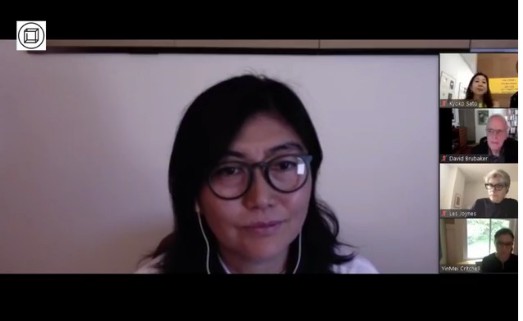
莱斯:
大卫,你有什么想法吗?
Les: David, do you have any contributions?
大卫:
是的。我在倾听每一个人。我的想法是,羅一Loy在创造实际接触的图像,这种接触带来了联系。她看的和注意的不只是对象。她看到的是一个真实的图像,这是她自己和另一个人的联系。她似乎意识到这个环境和她自己的存在并没有分离如果我可以这么说的话。我想说的是,我发现这些画和视频配合得很好。羅一的研究兴趣包括评估数字技术和手工之间的差异。我得到的是这样的:她关于这些手工画的目的和能力的评论,似乎也适用于她的视频制作。这些视频图像——其中一些现在已经在我们这里播放——经过编辑,使它们看起来像在黑色背景中漂浮的独立的人类瞬间。随着每次拍摄的展开,它漂浮,滑行,然后慢慢消失;另一个移动图像胶囊出现或浮入。视频图像是街头真实事件的记录;但当它们漂过去的时候,它们也获得了一种独特性,使它们个性化。毫无疑问,这些视频图像是纽约真实事件的记录;不同的是,这些图像也代表了一个个性化的框架,每个事件作为一个亲密的图像。视频作为一种图像而不仅仅是理解中的一个事实来代表真实。因此,视频的媒介是一种物质现实的文件,有时包括羅一走在“相机”上;它也呈现了移动的图像,看一个人作为一个真实事件的目击者。我们正在进行的讨论很有价值。用不同的方式来创作艺术,这样就是关于人们怎样相互联系,这是非常重要的。
David: Yes. I am listening to everyone. My thought is that Loy is creating images about the actual contact that brings connection. It is not just the object that she is looking at and noticing. She is looking at an actual image which is the context of her own living connection with another person. And it seems that the realization is that this context is not separate from her own self-existence if I can put it that way. And I’d just like to say that I find that the drawings and the videos go together well. Loy's research interests include assessment of the difference between digital and handmade. What I get is this: her remarks about the purpose and capacity of the drawings, which are handmade, also seem to apply to her video productions. The video images – some of them are here on zoom right now – are edited so that they look like independent moments of human looking that float along as if in a stream of a black background. As each long-take unfolds, it floats, glides up, and slowly disappears; another moving-image capsule appears or floats in. The video images are documents of real events on the street; but as they float on by, they also acquire a uniqueness that personalizes them. There is no doubt that the video images are records of real events in New York; the difference is that the images also represent a personalized framing of each event as an intimate image. The video represents the real as an image and not just as a fact in the understanding. So the medium of video is a document of the physical reality that at times includes Loy Luo walking “on camera”; it also presents moving images of looking personally as an eyewitness at a real event. The discussion we are having is very valuable. This idea of making art in a different way so that it about how people connect with each other is very important.
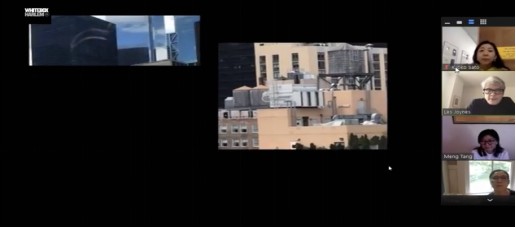
莱斯:
还有别的想法吗?恭子,我也知道你想说点什么。
Les: Anybody else? Kyoko, I also know you wanted to say something.
恭子:
是的,跟唐梦的评论有关。我一直在寻找艺术家来展示,寻找那些在大流行期间继续创作艺术的艺术家。然后有一天,羅一出现了,当然这是完美的。因为作为策展人,我现在追求的主题之一就是影响,影响时代。就像一个艺术家,同样的解释方式,这就是为什么我很高兴这次展示她。
Kyoko: Yes, just related to Meng Tang’s comments. I’ve been looking for artists to present, artists who have been continuing to make art during the Pandemic, that’s what I’ve been looking for. And then in one day, Loy showed up, and of course it was perfect. And because as a curator, one of the themes I’m pursuing right now is affecting, affecting the time. Just like an artist, similar way by that clarification, so that's why I am really happy to present her this time.
莱斯:
谢谢。还有其他意见吗?随着我们的演讲接近尾声,首先我想请所有想做结语评论的人发言。
我们真的很感谢每一位做出贡献的人,尤其是羅一,她让我们了解了她思考的方式,同时也是了解一位来自中国的人如何看待纽约市以及他们的印象,这对我们来说总是非常重要的,因为我们创建和展示的世界是关于连接的世界。羅一是带着一种诗意的联结来做这件事的,这真的很有意义。我想问一下在座的各位最后有什么意见吗?
Les: Thank you. Any other comments on that? As we're moving towards the end of our talk, first of all I want to give the floor to anybody who wants to make a closing comment at this time.
We're really grateful for everybody that contributed and especially Loy who is giving us a inside look at the way she's thinking, but also as one way of understanding how someone coming over from China is looking at New York City and what their impressions are, which are always really important to us because the world that we create and manifest is about connections after all. And, Loy is doing it with a sense of a poetic connection so that's really meaningful. But I want to open up, just to ask anybody here if they would like to bring in any final comments, please.
唐梦:
我能快速评论一下吗?我认为女性艺术家的作品总体上使艺术世界现代化了。这就是我的感觉。我认为原因有很多,但是在大流行时期,我看到很多伟大的女艺术家的作品让我很高兴。我真的很感激。
Meng: Can I make a very quick comment? I think that female artists’ work in general modernized the art world. That’s my feeling about it. I think the reason, there are so many reasons, but during the pandemic’s time, I think I see a lot of great female artists’ works that pleased me. I really appreciate that.
莱斯:
我可以对此发表评论。所以,在这次讨论中,我们要讨论的是你是如何创作艺术的,以及你在这场流行病中的经历。所以这个想法是关于美国的流行病。你们看到了我们在接受美国和欧洲爆发的流行病时所做的努力。例如,很多人在1月,2月说没有疾病大流行,但是我们意识到有一个,现在在美国,我们看到一个挑战我们应该做的不同的解释。对吧?戴上面具吗?不戴面具?艺术家们创作的作品都是关于艺术家当时的状况,但它不必要谈论流行病。
Les: I can comment on that. So, what we're also opening up in this discussion is how you’re making art, and about your experience in the Pandemic. So the idea is the Pandemic in the United States. You saw the struggle that we had, in accepting that there was a pandemic in the United States and Europe. For example, a lot of people said in January, February said there was no pandemic, there is no epidemic, but then we realized there was one and now in the United States, we see that there is a challenge with different interpretations of what we should do. Right? Wear a mask? Don’t wear a mask? And artists are creating artwork that talks about either the artist’s condition at this time, but it doesn't necessarily talk about the Pandemic.
羅一:
是的,我们不需要一个“思维面具”。人们总习惯用“面具思维”来思考一切。例如,既然有一种流行病,我们应该表示一种特殊的“流行病面孔”,穿“流行病服装”等等。就像我们总是戴着面具一样,我们无法放下它们。这是一回事。但我们在这个时候做艺术就是真的在讨论我们在这个时候的真实状况。
Loy: Yes, we don't need a “mask in the mind”. . People are used to thinking about everything in a "masked mind". For example, since there is a pandemic, we should show a special "pandemic face", wear "pandemic clothes", etc. Just like we wear masks all the time, we can't put them down. It's the same thing. But the fact that we're doing art at this time is really talking about the reality of our situation at this time.
莱斯:
还有其他意见吗?
Les: Any other comments?
大卫:
我想谈谈面具和减少障碍。我认为这个展览,包括这些图画和现在网上的视频,是在探索一个想法,即使是在拥有数以百万计的人的当代高科技城市中心,我们每个人都可以培养一种接近自我存在和接近他人的方式。视频显示了这种组合。其中有从上往下拍摄的令人惊叹的长镜头展示了游行的人分布在街道上,还有一些特写镜头,比如羅一在街角采访的那些人物。这两种图像同时漂浮在一起。这符合演讲者在其中一个视频中所说的。我想他的名字叫迪恩·艾伦。他在谈到大流行期间的游行时说:这关乎每个人,关乎唤醒他的邻居。在我看来,羅一的实验是在利用一个强大的时刻,它提供了一个重要的信息:它们表明,外面的许多游行者受到一种感觉或想法的激励,这种感觉或想法与她试图通过画作传达的感觉或想法类似。最重要的是要对每一个需要帮助的独特个体的价值有所认识。通过更深刻地认识到这一点,我们对彼此的同情就会增长。所以我认为羅一的作品整体上有助于为此时此刻正在发生的许多事件带来一些统一。
David: I’d like to say something about masks and reducing barriers. I think that the show, with the drawings and now the videos online, is exploring the idea that even in contemporary high-tech urban centers with millions of people, each of us can cultivate a way of being closer to self-existence and to others. The videos show this combination. There are amazing long-takes shot from above with marchers spread across the streets below, and there are close-ups of specific figures like those that Loy Luo interviews on street corners. Both sorts of image float by each other at the same time. This fits what a speaker says in one of the videos. I think his name is Dion Allen. He says this about marching during the pandemic: this is about everyone, and it is about waking-up his neighborhood. For me, Loy Luo’s experiments are tapping into a powerful moment that offers an important message: they suggest that many of the marchers outside are motivated by a feeling or thought like the one she is trying to communicate with the drawings. What is most important is to open up to an awareness of the value of each unique human individual in need. By having a greater awareness of this, our compassion for each other can grow. So I think Loy Luo’s work as a whole helps to bring some unity to the many events that are going on at this time and moment.
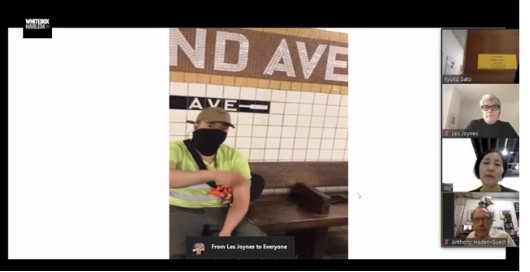
羅一:
谢谢。我还画了一些无家可归者和乞丐的画像。我将画更多无家可归的人,和在流行病中工作并支持这个城市的基础工人。总有很多人在外面工作,而不是每个人都呆在家里。如果那样的话,我就不能出去了。疫情中许多护士、医生和许多人都在街上工作着,我尊敬他们。
Loy: Thank you I also drew portraits of homeless people and beggars. I'm going to draw more homeless people, and basic workers who are working in the Pandemic and supporting the city. There are always a lot of people working outside instead of everyone staying at home. In that case, I can't go out. Many nurses, doctors and many other people are working on the streets during the pandemic. I respect them.
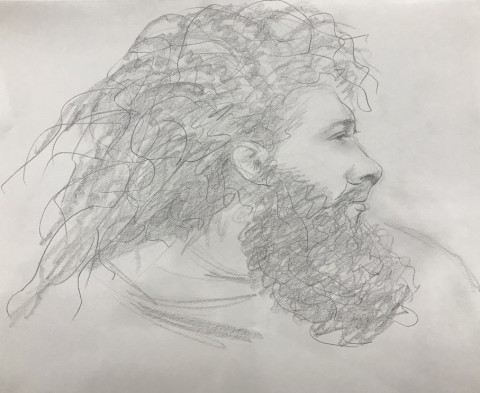
《流浪者》羅一 速写11*14 英寸 2020年8月
Vagrant Loy Luo sketch 11”*14”8/2020
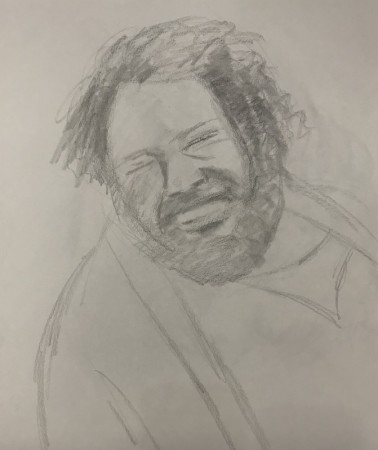
《无家可归者》羅一 速写11*14 英寸 2020年8月
Homeless Loy Luo sketch 11”*14”8/2020
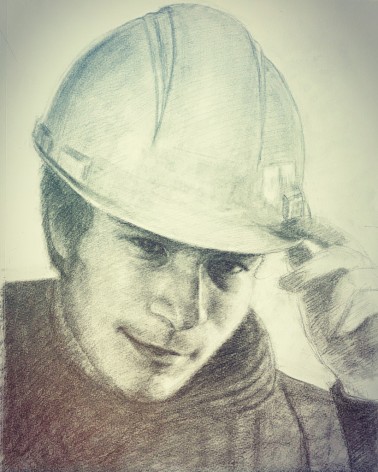
《疫情搬运工》羅一 速写11*14 英寸 2020年3月
Pandemic Porter Loy Luo sketch 11”*14”/2020
莱斯:
谢谢。还有人吗?我一会儿会把这个给恭子,但是我也想问胡安的意见?
Les: Thank you. Anybody else? I’m going bring this over to Kyoko in one moment, but also I want to ask Juan for his comments?
胡安:
我每天都看这个展览,我从一开始就和羅一交谈,我认为她试图做的,本质上是揭开这个主题。她认为我们总是带着一个自我的面具。在不同的时间,不同的时刻,我们需要不同的面具,这取决于我们在做什么,和谁见面等等。所以我认为她的要求是,最重要的是,揭露我们共同拥有的内在自我,我们所有人身上的人性。因此,在案例中,它们被表达得非常优雅。事实上,所有的肖像,绘画,都有生命。没有一个是简单的画出来的脸,额头和眼睛周围的线条。每个成年人都有自己美丽的表情。你几乎想和他们说话。请结束我的话,对我来说,她正在揭开面纱。
现在,我们要加一点评论,给你们所有人一个建议。白盒子于2月开始了一场由来自武汉的田明举办的展览,我们称之为“困在武汉”,1月19日他无法离开武汉来参加他的开幕式。从那时起,我们就致力于举办与时代相符的展览,以反映我们所经历的这一时刻,这是对我们余生和历史的巨大纪念。我们从来没有,我们经历过9/11,我们经历过这个或那个,但自从1918年以来,我们再也没有在这个国家看到过它。这是非常重要的。
羅一也在添砖加瓦。她亲历了整个2月到8月的一系列展览,从被困在武汉,到20世纪80年代中国艺术家从纽约东村移民到纽约,然后我们有了一些成长和痛苦的夜语,这些都是关于房子和家的。在这些悲剧性的脸上,房子和家的居民,当他们离开他们的房子和家,走上街头,羅一发现了他们,揭开了他们的面纱,为我们画了他们。安东尼为《白热》杂志写了非常漂亮的文章,已经有一个系列了,他还将写一篇漂亮的文章,描述整个哈莱姆区怀特博克流行病的图片。
我要感谢你,莱斯,你是一个非常出色的主持人,还有所有参与的人。
Juan:I think in my opinion, and I see this exhibition every day, I spoke to Loy from the beginning, what I think she's trying to do, in essence, is to unmask the subject. She maintains that we always carry a mask of ourselves. In different times, at different moments, we need different masks, depending on what we are doing, who we are meeting and so forth. So I think her request is, more than anything else, to unmask and reveal that inner selves that we’ll share, that humanity in all of us. Therefore, they are expressed, very elegantly, in the cases. In fact, all the portraits, the drawings, have life in them. None of them are like, simply illustrated faces, lines that move around foreheads and eyes. Every adult has a beautiful expression. You almost want to talk to them. Just end my saying, to me, she is unmasking.
Now, we’ll add a little bit of a comment, a pitch to all of you. WhiteBox in February began an exhibition by Tian Ming, also well known by Chunchen Wang, from Wuhan, we called it “Trapped in Wuhan”, he couldn’t leave Wuhan on January 19 to come to his opening. Since then we have dedicated ourselves to do exhibitions that are really pretty much in tune with the times reflecting the moment we're traversing, this enormous memorial for the rest of our lives and in history as well. We have never been, we suffered 9/11, we suffer this or that, but ever since 1918, we haven't seen it in this country. This is momentous and she is adding to it. Loy. She's wrapping up an entire February through August, series of exhibitions we've done, from trapped in Wuhan, to the immigration of Chinese artists from the nineteen-eighties to the East Village, New York, and then we have some growth and lurching nocturnal whispers of pain, which are all about house and home. In the tragic face, right below the house and home, the inhabitants of the house and home, when they leave their house and home, hit the streets, and Loy finds them, unmasks them, draws them for us. Anthony writes a very beautiful piece for his series for the White Hot magazine, it has already run a series, and would be writing a beautiful article, beautiful pictures of entire pandemic at WhiteBox, Harlem. I would like to thank you, Les, who has been a beautiful moderator, and everybody else who has participated, thank you so much!
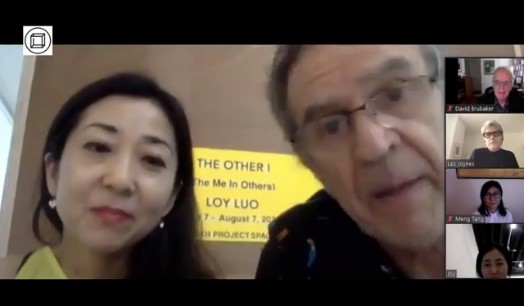
莱斯:
谢谢。恭子,轮到你了。
Les: Thank you. Kyoko, over to you.
恭子:
非常感谢,你太棒了,每个人都很棒,连技术都很棒。春辰,太棒了。这里的每个人都是最好的。
Kyoko: Thank you so much, you are so great and everyone is great and even the tech. Chunchen,is amazing. Everybody is the best here.
羅一:
因为每次讨论都会给我一些新的想法。所以,谢谢大家,我会把新想法放在网站上,这样我们就可以再次讨论。谢谢大家!这真的是一个了不起的讨论。
Loy: Because every discussion gives me some new ideas. So, thank you, and I'll post my new ideas on my website so we can talk about them again. Thank you! This is really a great discussion.
莱斯:
总之,我要感谢在场的每一个人,感谢正在观看这个节目的观众,也感谢我们的小组成员,但首先我要非常感谢恭子和胡安邀请我担任主持人,你们是一个非常棒的团队。我真的很高兴我们能进行这样的对话,希望这只是众多对话中的一个。很高兴见到你,来自北京中央美术博物馆的王春辰,非常感谢,很高兴再次见到你。此外,来自武汉纺织大学的David Brubaker,来自皇后学院的殷梅Yin Mei,来自纽约的Anthony Haden-Guest, Christopher Pelham,感谢你分享你作为一个主体和表演者的观点。感谢在明尼苏达大学任教的唐梦。谢谢大家。
最后,非常感谢我们今天的艺术家羅一。
Les: So, in summary, I want to thank everybody here, our audience that’s watching this, as well as our panelists, but first I want to give a big thank you to Kyoko, and Juan for inviting me as moderator and you’ve been a terrific team. I’m really glad that we had this conversation, hopefully one of many. Terrific to see you, Chunchen Wang from CAFA’s Art Museum in Beijing, thank you so much, it's great to see you again. Also, David Brubaker, from the Wuhan Textile University, Yin Mei from Queens College, Anthony Haden-Guest in New York City, Christopher Pelham, Thank you for sharing your views of being a subject and also performance. Meng Tang, who is teaching at the University of Minnesota, thank you all.
and finally, a big thank you to Loy, our artist today.
欲了解更多相关情况欢迎登陆http://www.loyluo.art和https://www.whiteboxny.org
视频转录:张娟
文档翻译:梁岩
图文统筹:羅一
Copyright Reserved 2000-2024 雅昌艺术网 版权所有
增值电信业务经营许可证(粤)B2-20030053广播电视制作经营许可证(粤)字第717号企业法人营业执照
 京公网安备 11011302000792号粤ICP备17056390号-4信息网络传播视听节目许可证1909402号互联网域名注册证书中国互联网举报中心
京公网安备 11011302000792号粤ICP备17056390号-4信息网络传播视听节目许可证1909402号互联网域名注册证书中国互联网举报中心
网络文化经营许可证粤网文[2018]3670-1221号网络出版服务许可证(总)网出证(粤)字第021号出版物经营许可证可信网站验证服务证书2012040503023850号